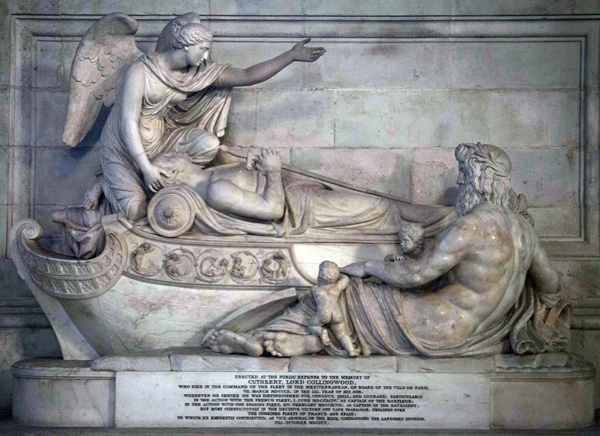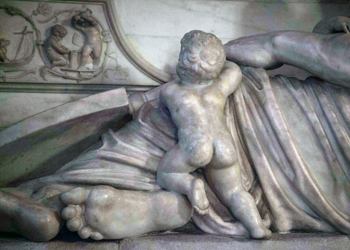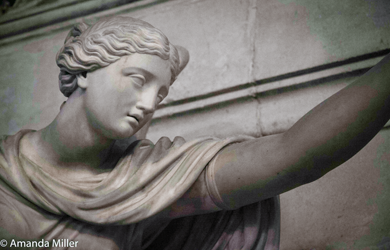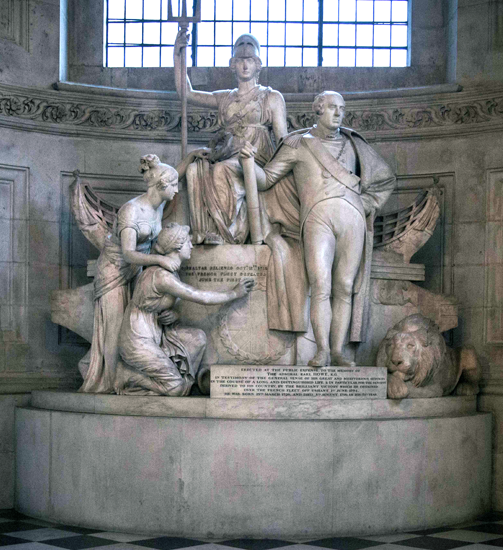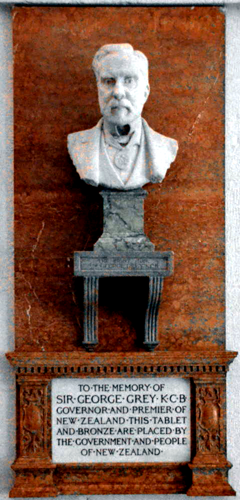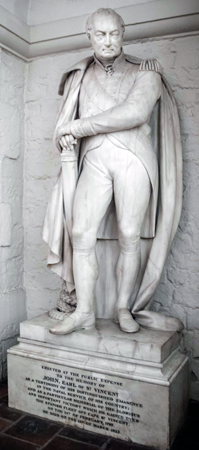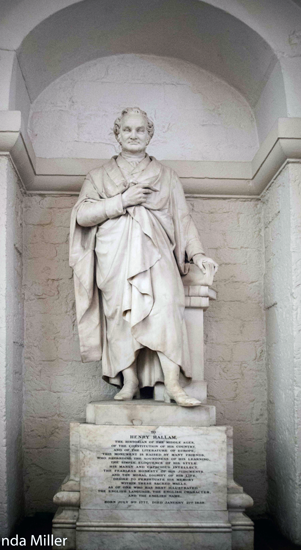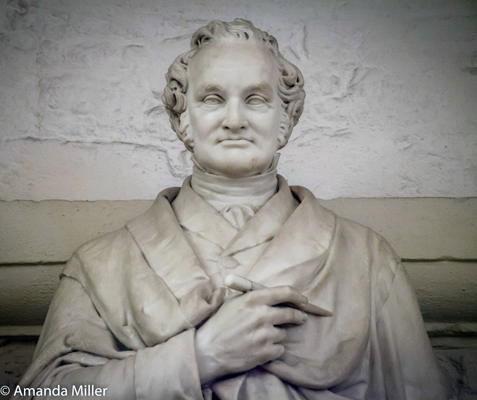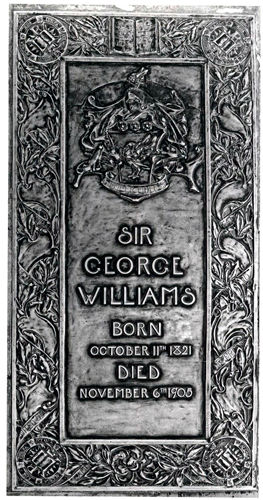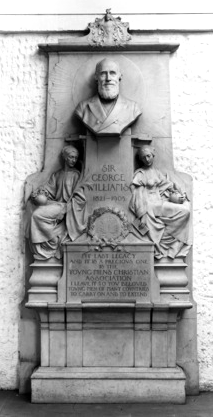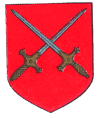 |
 |
City Of London - 2 ST. PAUL'S CATHEDRAL |
 |
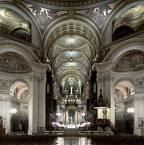 |
| Underground Station: St Paul's (Central Line). Entrance fee is £18 (with concessions and £15 if pre-booked on line). No sight seeing on Sunday. Website: https://www.stpauls.co.uk/ | ||||
Chapel of All Souls Chapel of St Dunstan Choir Crossing Nave -North Aisle Nave (Body of) North Transept Nave - South Aisle South Transept
The Crypt
Chapel of St Faith South Aisle Nave North Aisle North-South Passage North Transept North-South Passage (E of Rotunda) Rotonda North-South Passage (W of Rotonda) South Transept
(Note: persons are listed in the index by the names by which they are most commonly known )
General Abercrombie Walter G Allen Sir Lawrence Alma-Tadema
Dr William Babbington Sir Nicholas Bacon James Barry Admiral of the Fleet David Beaty Max Beerbohn Admiral Beresford William Blake Bishop Blomfield Captain Burges RN
Sir William Cockayne Randolph Caldecott Admiral Codrington Sir Astley Paston Cooper Admiral Collingwood Captain John Cooke General Cornwallis Bishop Creighton
William Ried Dick Sir Frank Dicksee Captain Duff General Dundas
General Eliot (Lord Heathfield)
Captain Faulknor George Frampton
General Gibb Alfred Gilbert Captain Glover RN General Gordon of Khartoum General Gore Sir John Goss
Henry Hallam General Hay Bishop Heber Sir Thomas Heneage William Hewitt William & Susannah Holder Robert Hooke John Howard Admiral Howe William Holman Hunt
Gen Sir John Inglis
Admiral of the Fleet John Jervis, Earl of St Vincent Dr Johnson Gen Sir John Jones Admiral of the Fleet Jackson Admiral of the Fleet John Jellicoe Sir William Jones
Lord Kitchener
Federick Lamb, 3rd Viscount Melbourne William Lamb, 2nd Viscount Melbourne Edwin Landseer General Lawrence Lawrence of Arabia Baron Lytton Frederick Lord Leighton (monument) (tomb)
Canon Henry Liddon Lutyens Admiral Edmund Lyons Cpt Edward Lyons RN
John MacDonald Gen Sir Charles MacGregor Admiral of the Fleet Madden Admiral Malcolm John Martyn Bishop Middleton John Everet Millais Dean Millman Robert Montgomery General Moore Captain James Moss
Field Marshal Napier General Charles Napier General William Napier Lord Nelson (monument) (tomb) Florence Nightingale
General Pakenham General Picton General W Ponsonby
George Richmond Joshua Reynolds Admiral of the Fleet Richards Captain Edward Riou RN Earl Roberts Admiral Rodney Sir William Russel
John Singer Sargeant Captain Scott General Skerrett General Stewart
Archbishop Frederick Temple Hamo Thornycroft General Torrens J M W Turner (monument) (grave slab)
Van Dyck
Sir Aston Webb Canon Webber Duke of Wellington (monument) (tomb) Captain Westcott RN Edmund Wiseman Sir John Wooley Sir Christopher Wren Jane Wren Mary Wren Col Sir William Wyllie
Those destroyed by the Great Fire (renderings)
Please note: I have attempted to arrange the monuments in a ordered manner around the church each in the correct place. Unfortunately I do not have a comprehensiveplan of St Paul's with all - or even some - of the monuments marked. So I have to relay on the written word. The RCHM volume on London: The City is excellent but, although the description of the monuments and their positions are clear and concise, the cut-off date means the majority of them are not included. There is always the possibility that some may have moved since the RCHM inventory was published in 1929.The equivalent Pevsner volume has no such cut-off date but the writer is selective about which monuments are included and when he reaches the Crypt to call several of the descriptions of the monuments 'brief' would be an overstatement! At time the writing is vague and a plan is not included; so, unless you are actually there or very familiar with the church, difficult and at time impossible to follow. I have produced my own plan which I hope will be helpful, which can be accessed here.I have also included a plan of the church from Dugdale's St Paul's from an etching by Wencelaus Hollar
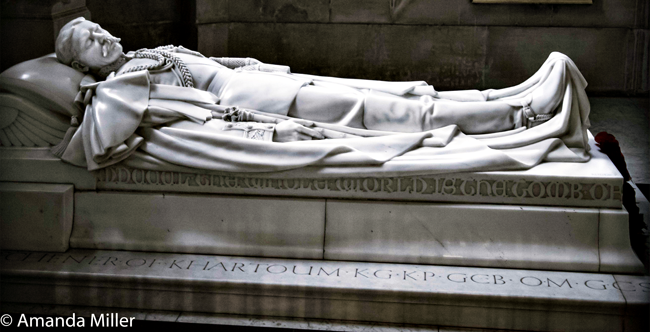 |
|
|
NAVE -
NORTH AISLE First Bay |
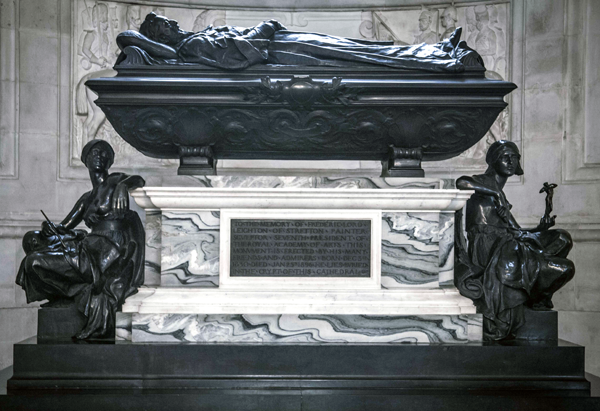 |
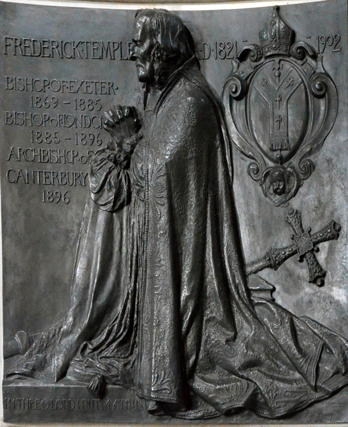 |
|
Frederick Leighton, 1st Baron Leighton (1896). Bronze effigy and allegorical figures of Painting and Sculpture. The effigy lies on a marble sarcophagus. Below bronze statuettes of allegorical figures: 'Sculpture' (who holds Lord Leighton's statue 'Sluggard') and 'Painting' By Sir Thomas Brock (1902) Lord Leighton was a painter and sculptor who received a knighthood in 1878 and was created baronet in 1886. He was given a peerage in the New Year's Honours 1896, the first artist to be so honoured, but died the following day. He thus holds the dubious record of holding a peerage for the shortest time. Seen behind is the 57th/77th Regiment Crimean War Memorial by Marochetti# |
Archbishop Frederick Temple (1902).
Archbishop
of Canterbury, who was father of a later Archbishop of
Canterbury, William Temple. He had been Bishop of London. He was buried in Canterbury
Cathedral. Bronze relief of the Archbishop at prayer by Pomeroy (1905) Photograph by George P Landow from The Victorian Web. Used with permission. |
| Second Bay |
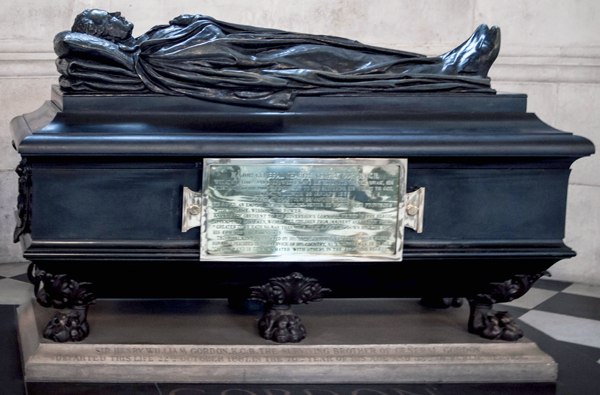 It is disgraceful to have to record that after his death his head was cut off and his body thrown into the River Nile |
 |
Mjr Gen Charles Gordon of Khartoum (1885) Bronze effigy on black marble tomb chest, by Boehm Also commemorated on this monument is his brother, Sir Henry William Gordon (1887) |
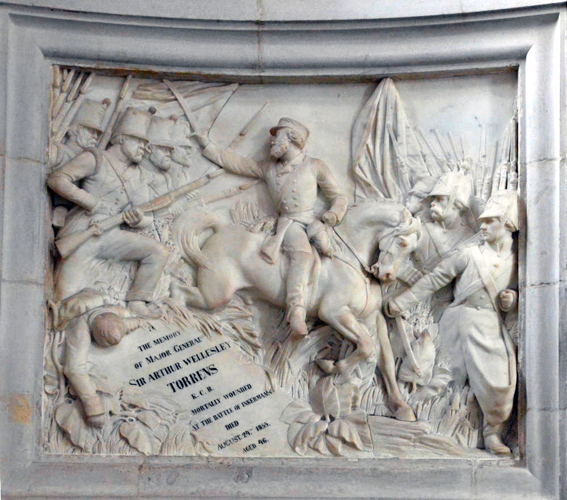 Behind the General Gordon monument are the following reliefs: 1.To the Afghan Campaign (1879-80) Marble by J. Forsyth 2. Above Major-General Sir Arthur Wellesley Torrens (1855) Crimean battle scene by Marochetti. He was badly wounded in the Crimean Campaign and died shortly afterwards. Buried in Père-Lachaise, Paris 3 Below: Major-General Sir Herbert Stewart (1885) Tripartite bronze with central portrait by Boehm. Anglo-Zulu War, First Boer Way. Commanded the Gordon relief expedition but died of wounds on the way back from Khartoum. Buried near the wells of Jakdul, where he died Photographs by George P Landow from The Victorian Web. Used with permission. |
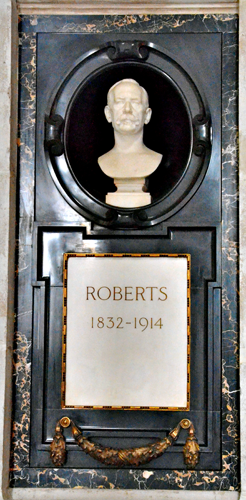 On pillar between the second and third bays: Field Marshal Frederick Sleigh Roberts, Earl Roberts (1914) Marble bust with bronze and marble surround by John Tweed One of the most successful British military commanders of his time. A man of small stature, he was affectionately known as 'Bobs'. In later life he became the symbol of the British Army. He died in France of pneumonia while visiting Indian troops during WWI |
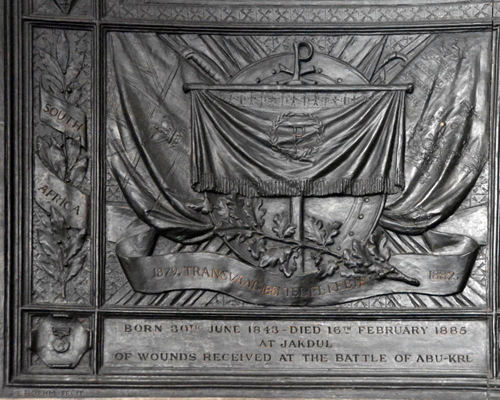 |
 |
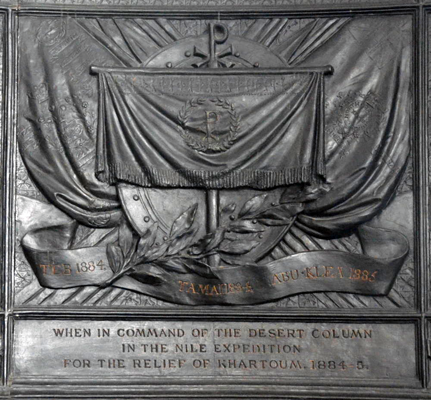 |
| Third Bay |
 |
William Lamb, 2nd Viscount Melbourne (1848) Whig statesman and Prime Minister 1835-1841. His wife was Lady Caroline Lamb, best known for her affair with Lord Byron. Also Frederick Lamb, 3rd Viscount Melbourne, Baron Beauvale (1853) . He was the younger brother of the Prime Minister. Because of his mother's numerous affairs, his parentage is said to be in doubt. The inscribed doors are 'false'. By Marochetti |
| NAVE (Body of) |
 |
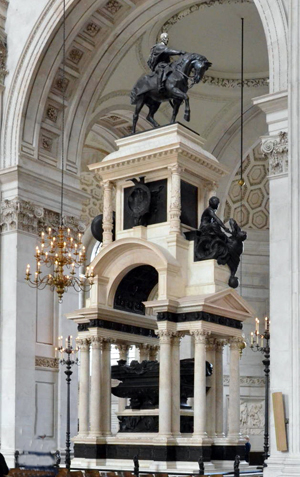 Photograph by George P Landow from The Victorian Web. Used with permission. |
.png) Photograph by George P Landow from The Victorian Web. Used with permission. |
 |
Field Marshal Arthur Wellesley, 1st Duke of Wellington (1852) Soldier and statesman. With Blücher the victor at Waterloo and twice Tory prime minister. The monument is by Alfred Stevens; begun in 1857, it was not finished until 1912, thirty seven years after Stevens's death. The equestrian statue is by Tweed. White marble with twelve columns; a contrasting dark bronze frieze with cherubs'' heads. Bronze panels on the pedestals list Wellington's victories. Recumbent bronze effigy of the Iron Duke lies on a sarcophagus under the main arch. Above two pairs of bronze allegorical figures sit at either end: Valour & Cowardice and Truth & Falsehood. Above is a bronze equestrian statue of the Duke, arm raised in command; by Tweed. |
|||
|
NAVE - SOUTH
AISLE First Bay |
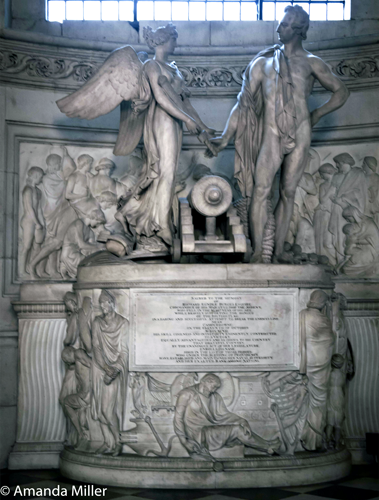 |
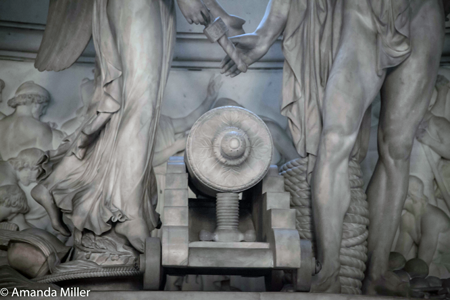
Captain Richard Rundle Burges RN (1797) Marble by Thomas Banks (1797-1802) Victory hands the young RN officer a sword. Without its pedestal and not in its original position. Cpt Burges was
killed aboard his ship HMS Ardent at the Battle of
Camperdown, an engagement in the French Revolutionary Wars.
|
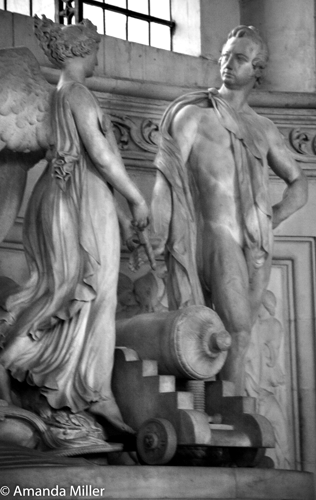 |
|
|
|||
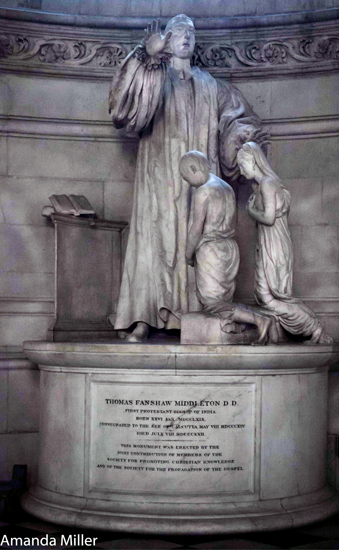 |
 Thomas Fanshaw Middleton DD, Bishop of Calcutta (1822) by J. G. Lough (1832) He died of sun stroke in 1822 and was buried in Calcutta Cathedral In the niche behind are reliefs representing Peace by W. Calder Marshall; from SW chapel. see above |
 Captain George Blagdon Westcott RN (1798) by Banks (1802-1805) On the plinth Father Nile with many children and flanking naval battle scenes. Not in situ. Killed in action at the Batlle of the Nile on board his ship HMS Majestic. Buried at sea Behind can be seen reliefs with battle scenes by Nobel: right to Cpt Edward Moubray Lyons RN (1855) with portrait by Matochetti (shown below); left to Granville Gower Loch (1853) Between these is a Biblical scene again from the SW chapel by Calder Marshall (1863). Also not in situ and without its pedestal. |
||
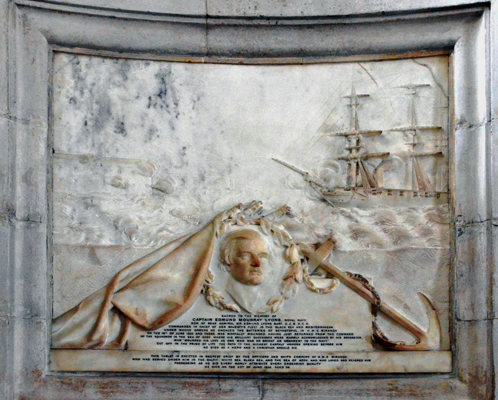 |
Cpt Lyons was wounded at Sebastopol while commanding HMS Miranda during the Crimean War. He died ten days later aged and was buried at Haydarpaşasa Cemetery, Üksküdar, Istanbul where there is a monument over his grave. Photograph by George P Landow from The Victorian Web. Used with permission. |
| CROSSING Four marble statues of great 18th century contributors to various aspects of human endeavour. |
 |
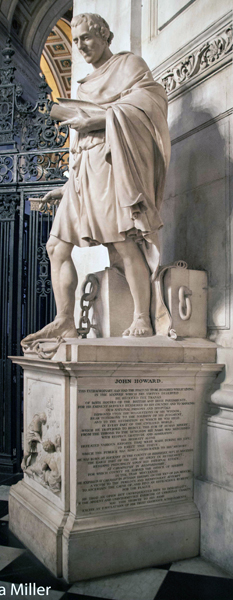 |
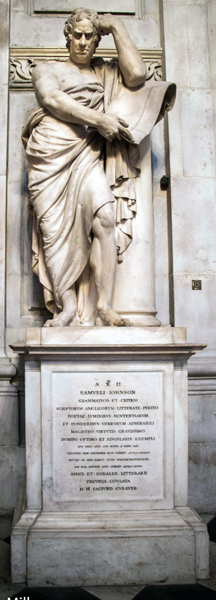 |
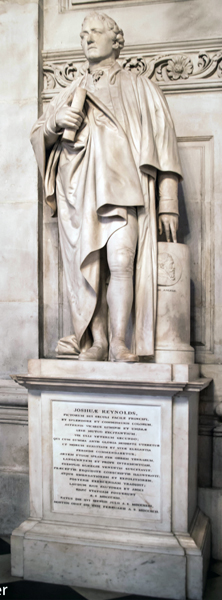 |
SW: Sir William Jones (1794) by Bacon Snr (1799) Philologist, judge and Orientalist. Buried in Calcutta. |
SE:
John Howard (1790) by Bacon
Snr (1791-5) Prison reformer. Buried in Dophinovka, Ukraine |
NE:
Dr Samuel Johnson (1784) by
Bacon Snr (1791-6) Writer, lexographer. Buried in Westminster Abbey |
NW:
Sir Joshua Reynolds (1792) by
Flaxman (1803-13) Artist. Buried in St Paul's |
| SOUTH
TRANSEPT West Aisle |
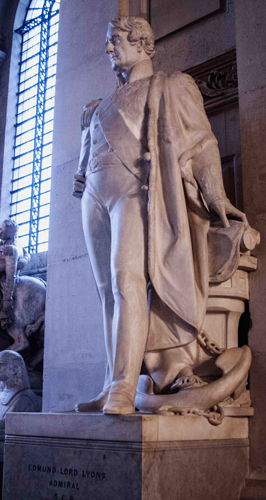 |
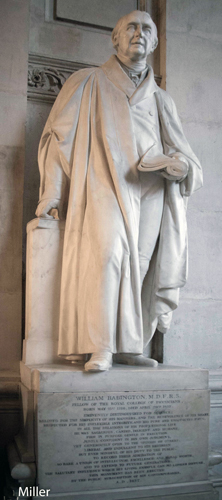 |
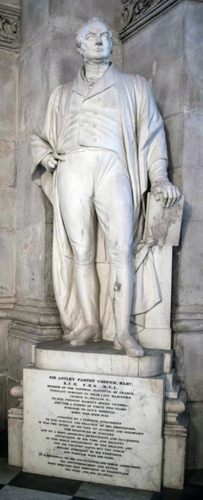 |
|
Admiral Edmund Lyons, 1st Baron
Lyons (1858) by Noble (1862) Fought in Crimean War. Buried in vault below the Fitzalan Chapel, Arundel, Sussex |
Dr William Babbington (1833)
by Behnes;
body modelled by M L Watson. Physician and minerologist |
Sir Astley
Paston Cooper (1842) by E H Baily.
Surgeon and anatomist. Buried in crypt of chapel of Thomas Guy, St Thomas Street, London |
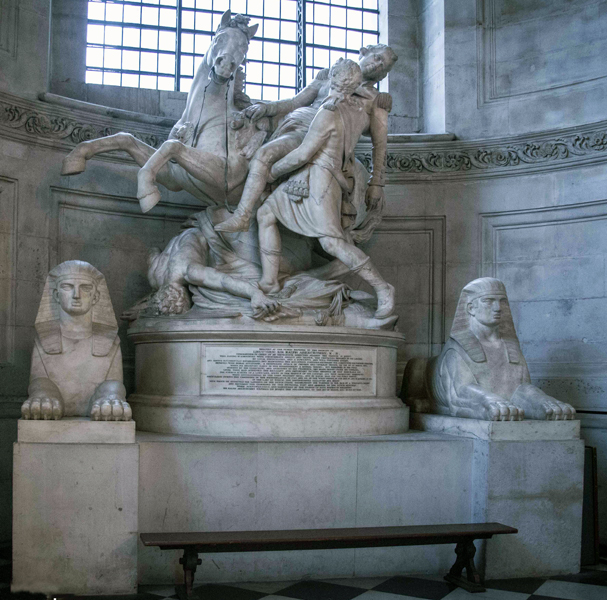 |
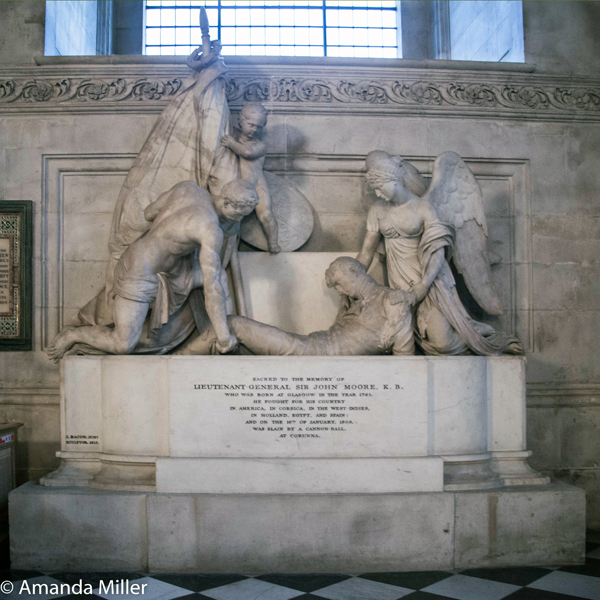 |
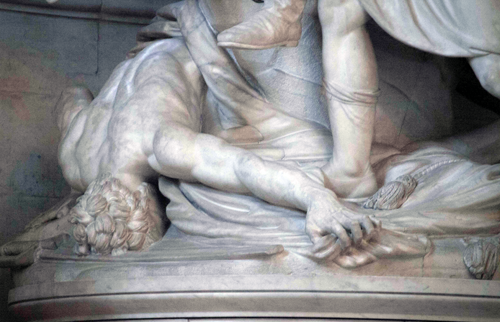 |
 |
|
Lt-Gen Sir Ralph Abercromby (1801) by Westmacott (1802-5) Soldier and politician. Injured at Battle of Alexandria (Napoleonic Wars) and died later aboard HMS Fondroyant. Buried in the commandery of the Grand Master of the Knights of St John, Malta. A square in Liverpool and a public house in Manchester are named after him. |
Lt-Gen Sir John Moore (1809) by Bacon Jnr (1810-15) Died at the Battle of Corunna (Peninsular War) and was buried in the ramparts of that town, where his monument may be seen. |
| NOT ILLUSTRATED |
| Gen Sir Isaac
Brock (1812) Relief by Westmacott (1815) Cpt Sir William Hoste by Thomas Campbell (1834) |
| Nave of South Transept |
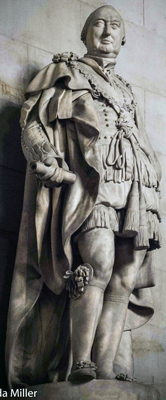 |
 |
 |
 |
 |
General Charles Cornwallis, 1st Marquess Cornwallis (1805) By Rossi (1811) Soldier and colonial administrator; remembered as a general in the American War of Independence. He died in India and is buried at Gauspur overlooking the Ganges. |
||||
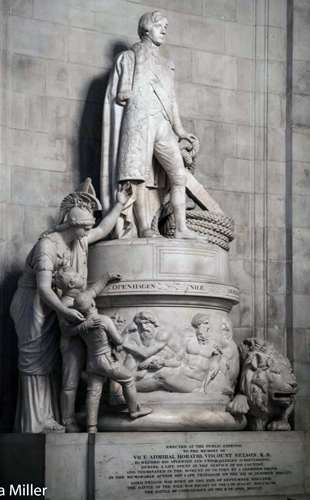 |
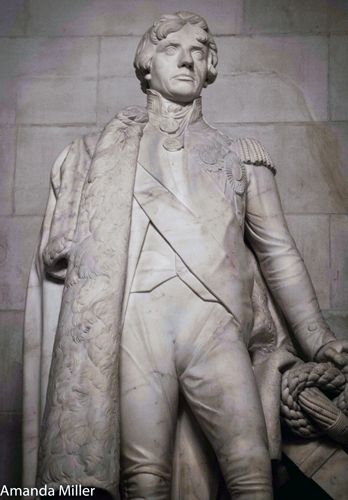 |
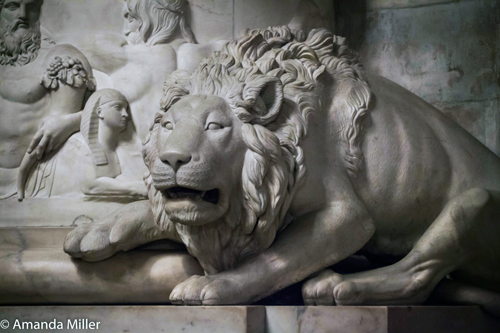 |
| Vice Admiral Horatio
Nelson, 1st Viscount Nelson (1805)
By Flaxman
(1808-18) Killed by a sniper on board HMS Victory at the Battle of Trafalgar. His body was preserved in a cask of brandy with camphor and myrrh and taken to Gibraltar; here it was transferred to a lead coffin containing spirit of wine (concentrated alcohol) and later buried in St Paul's (see below) |
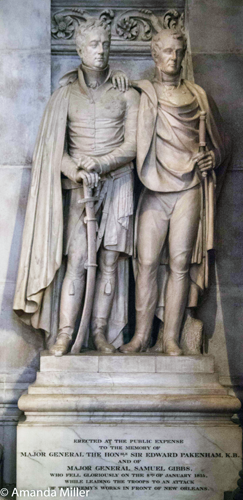 |
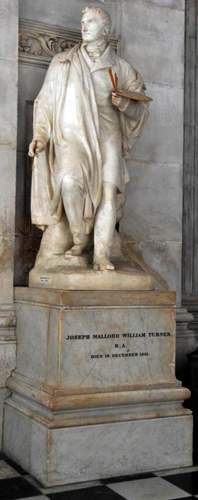 |

|
||
Mjr-Gen Sir Edward Pakenham & Mjr-Gen Samuel Gibbs. By Westmacott,(1816-23) They were both killed at the Battle of New Orleans (American Civil War) in 1815 Mjr-Gen Pakenham's body was returned to Ireland in a cask of rum to be buried in the family vault in Killcican, County West Meath. |
Above and left:
Joseph Mallord William Turner
(1851)
by
MacDowell Buried in St Paul's (see below) Photographs of Turner are by George P Landow from The Victorian Web. Used with permission. |
|||
| East Aisle of South Transept |
|
|
 |
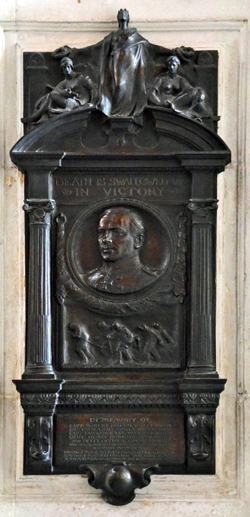 |
 |
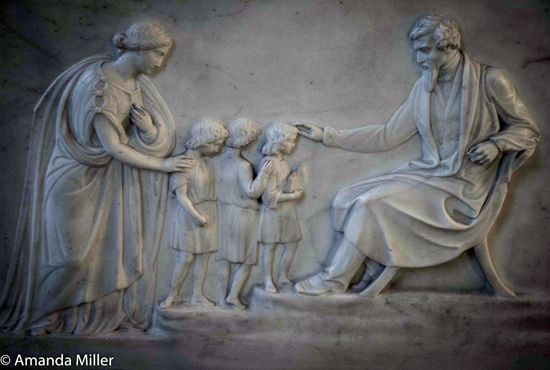 |
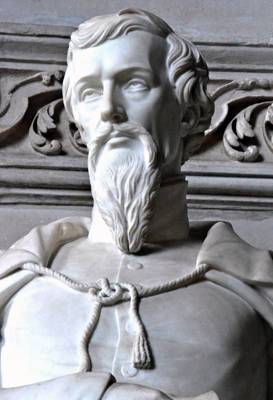 |
|
Far left: General Sir George Augustus Eliot, 1st Baron Heathfield
(1790)
by
Rossi (1823-25)
Fought in the Seven Years'
War and famous for his command at the Great Siege of Gibraltar.
Died at Schloss Kalkofen, Azchen. He was buried initially in the
grounds of the Schloss; he was then reburied at
Heathfield, Sussex; and later still buried at Buckland
Monachorum, Devon. Centre left: Captain Scott and members of his expedition Bronze by Sir Nicholson Babb (1915) 'Scott of the Antarctic' The bodies of Scott and his remaining two companions lie in the Antarctic ice; a wooden cross marks the site. Near left and above: Brigadier-General Sir Henry Montgomery Lawence (1876) By John Graham Lough. Buried at Luknow, India. |
||||
| Photographs of Cpt Scott and Gen Lawrence are by George P Landow from The Victorian Web. Used with permission. Except that where indicated which is by Amada Miller | ||||
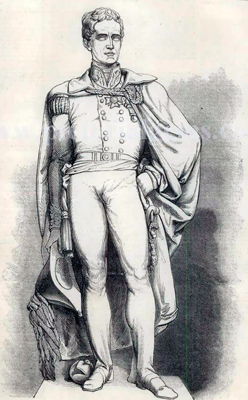 |
Mjr-Gen Sir John Thomas Jones Bt (1843) By William Behnes, who also was the sculptor. He took part in a number of campaignsin the early 19th century as a military engineer. He was highly regarded by Willington whom he advised on the modernisarion of the fortifications of Gibraltar. He was also a first class cricketer Lt Col The Hon Henry Cadogan (1813) Relief by Chantry 1814 (not illustrated) Mjr-Gen Robert Ross (1814) Relief by Josephus Kendrick 1823 (not illustrated) |
|
NORTH TRANSEPT West Aisle |
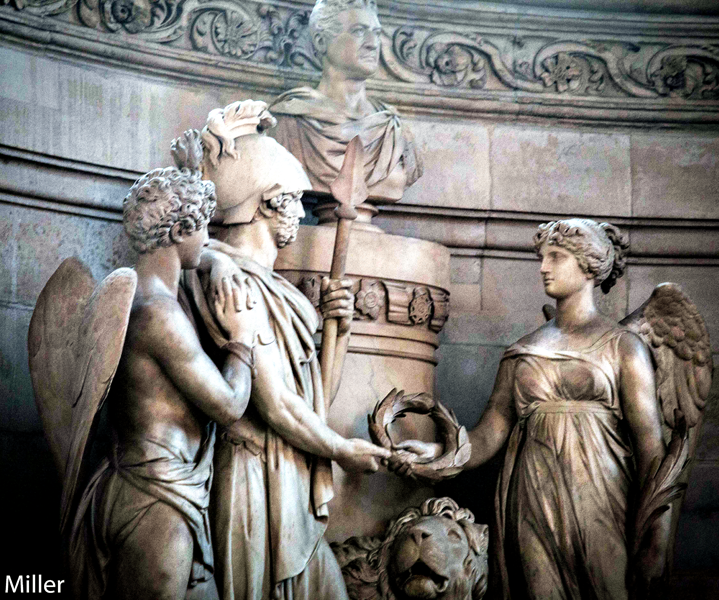 |
Left:
Lt-Gen Sir
Thomas Picton (1815)
by Sebastian Gahagan
(1816) '...a rough foul-mouthed devil who ever
lived...' (Wellington)
RELIEFS - NOT SHOWN
Mjr-Gen. Daniel Houghton (1811) by Chantrey. KIA at Albuera (Penninsular War)
|
| Nave of North Transept |
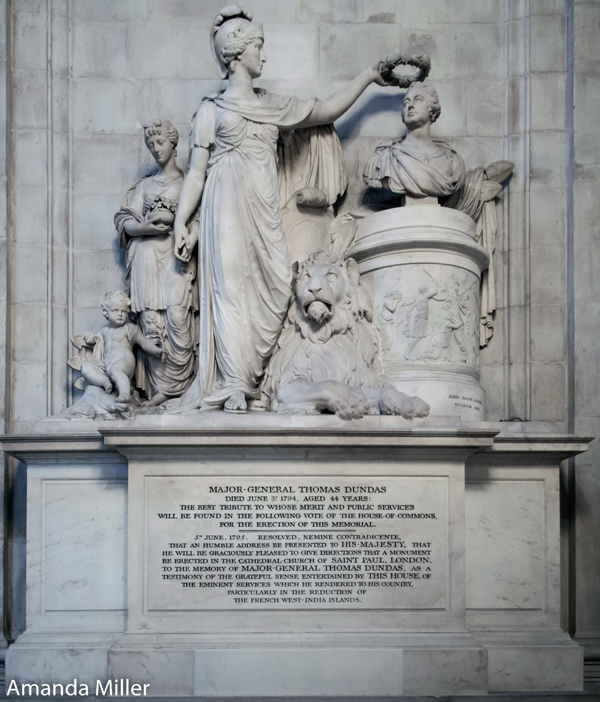 |
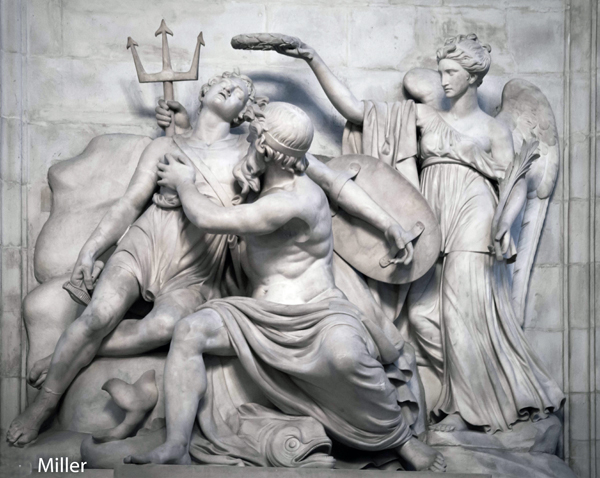
Left:
Mjr-Gen.Thomas Dundas
(1794)
by
Bacon Jnr (1798-1805) |
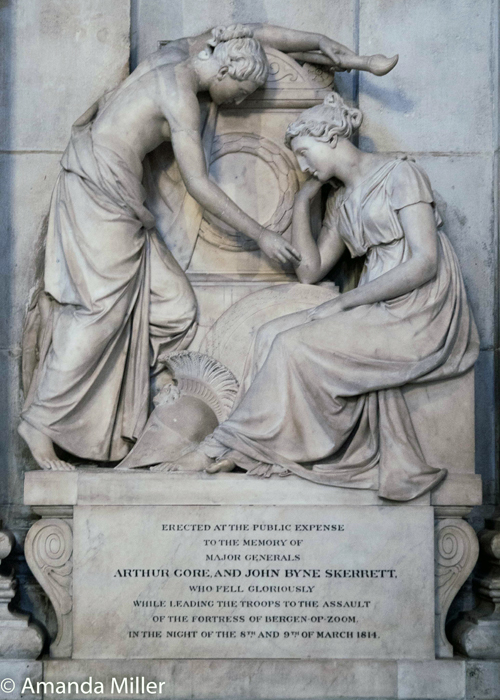 |
 Left: Mjr-Gens Arthur Gore and John Byne Skerrett Designed by W Tallimache; carved by Chantrey Both KIA 1814 during the assault at Bergen op Zoom, Netherlands (Peninsular War) Above: Mjr-Gen. Andrew Hay (1814) by Hopper Fought in the American Revolutionary War, the French Revolutionary War and the Peninsular War. Shortly after news of Napoleon's abdication he was KIA at he Battle of Bayonne (France), the last battle of the Peninsular War. |
| RELIEFS - NOT SHOWN |
|
Mjr-Gens Robert Craufurd and Mjr-Gen Henry Mackinnon (1812)
by Bacon Jnr.
Gen Mackinnon was killed by the explosion of an enemy magazine
at the siege of Ciudad Rodrigo (Peninsular War); Gen. Craufurd -
known as 'Black Bob, because of his mood swings - died of wounds
also at that siege. Mjr-Gen J K Mackenzie and Brig-Gen. Langworth (1809) designed by C Manning; executed by S Manning. Both killed at Talavera (Peninsular War) |
| East Aisle of North Transept |
| RELIEFS - NOT SHOWN |
|
Reginald Brabazon 12th Earl of Meath (1929)
by Herman Cawthra
Politician and philanthropist. Responsible for the
introduction of Empire Day. Buried in the church yard of the
Church of Ireland church in Delgany, County Wicklow. Admiral Sir Charles Napier R N (1860) by G G Adams (1860) Served sixty years in the Royal Navy in the French Revolutionary Wars, Napoleonic Wars, War of 1812, Egyptian-Ottoman/Syrian War and the Crimean War. He was a dark, eccentric and untidy man of 14 stone and variously nicknamed 'Swarthy Charlie', 'Mad Charlie' or 'Dirty Charlie'. Mjr-Gen. Bernard Foord Bowes (1812) by Chantrey Served in Ireland, America, Gibraltar. Kia Salamanca, Spain (Peninsular War) Mjr-Gen John Gaspard Le Marchant (1812) designed by J Smith; executed by Rossi. Served in French Revolutionary and Napoleonic Wars. Kia Salamanca, Spain (Peninsular War) Buried in Olive Grove near where he died. Sir Arthur Seymour Sullivan (1900) bronze by Goscombe John (1903) Composer best known for operatic collaboration with librettist W S Gilbert Sir John Stainer (1902) by H Pegram (1903) Composer and organist. For a time organist at St Paul's |
| CHOIR |
 |
Image not available | Image not available |
|
Above: Bishop Charles James Blomfield DD (1857) marble by George Richmond (1863) Buried at All Saints, Fulham, London Left: [1] (south aisle) John Donne (1631) By Nicholas Stone. Dean of St Paul's and poet. The effigy was probably conceived as recumbent but later the urn was added and it was set upright because of lack of space. Completion of the effigy was subcontracted to Humphrey Meyer and the original surround to Robert Flower. The epitaph is by Donne himself. Damaged in the Great Fire but restored from the etchings of Hollar and set here. (see below for a rendering of the monument before the fire); a rendering of the whole monument before the fire is shown below. White marble effigy Far Left: Bishop Mandell Creighton (1901) Bronze statue by Sir Hamo Thornycroft (1905) Buried in the crypt (see below) |
|
THE CRYPT South Aisle of Crypt Note: What is termed 'the south aisle' (and 'the north aisle') of the crypt does not begin at the crossing and then progress to the west end of the church, as is would in the body of the church. Rather it begins (for these purposes) at the eastermost end of the crypt and continues to the westernmost. That is there is no 'Chapel of St Faith Aisles' equivalent to aisles of the choir. The are very many monuments in the crypt often relatively simple wall tablets. I will attempt to find a list of these to add in due course. |
| Against the East Wall | ||
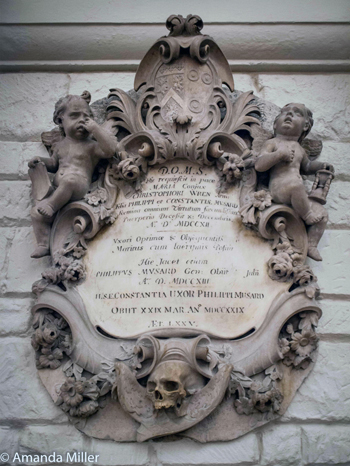 |
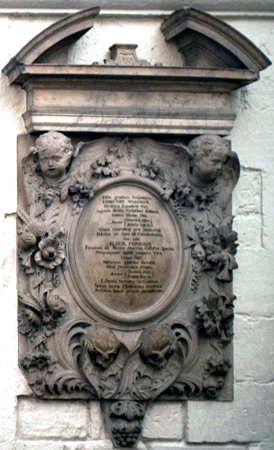 |
 |
| Mary Wren (1712) Daughter-in-law of Sir Christopher. |
[11]
Edmund Wiseman (1704)
and Eliza, his wife Attrib to William Woodman Snr |
William Blake (1827) Poet, painter and printer; his most famous poem being 'And did those feet in ancient times' Buried in Bunhill Fields, London, where a stone marks his approximate grave site, the actual site being lost. He and his wife also have a memorial in Westminster Abbey |
| In the Recess | ||
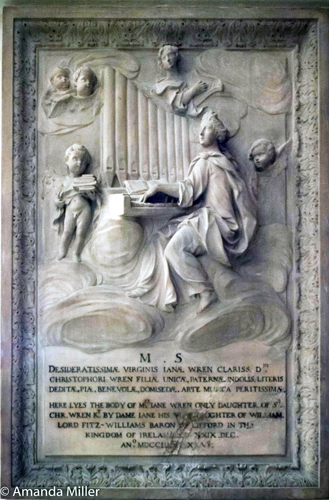 |
 |
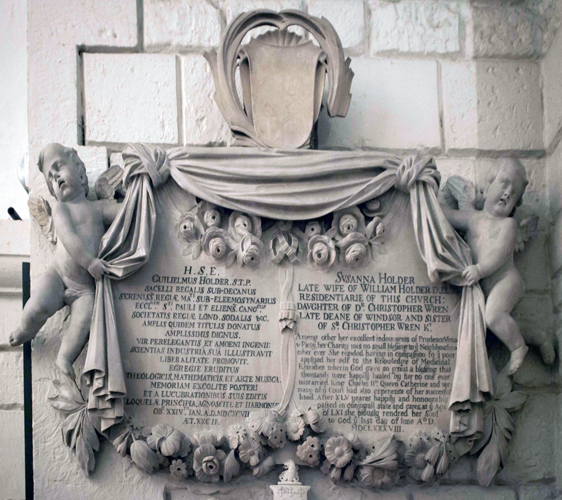 |
| [12] Jane Wren (1702) Wren's
only daughter. By Francis Bird |
Randolph Caldecott (1846) by Alfred Gilbert (1887-95) The figure is in painted aluminium whilst the pillars are bronze. He was an artist and book illustrator. He died in St Augustine, Florida, where he is buried. There is also a memorial to him in Chester Cathedral, his birth place. |
[13]
William (1697) & Susannah Holder,
Wren's sister, - By Gibbons. Note that his inscription is in Latin while hers is in English. |
| South Wall - First Recess |
 |
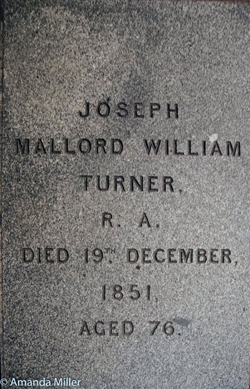 |
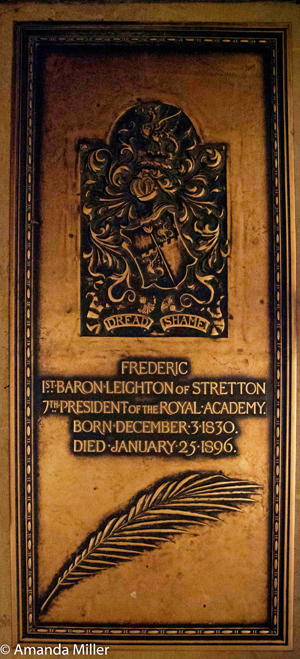 |
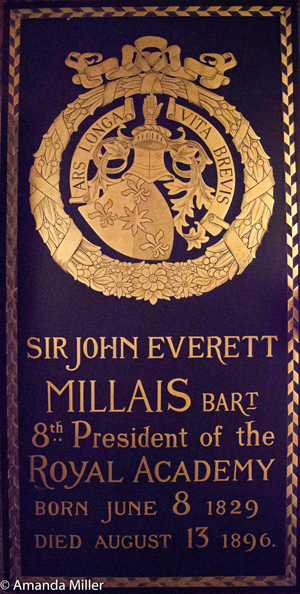 |
|
|
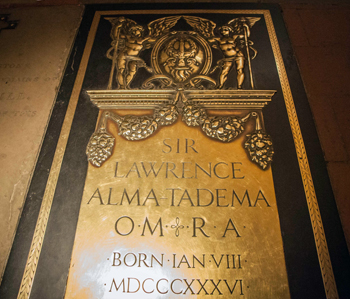 |
||
| Immediately above Wren's stone is a
tablet reading 'Remember the men who made the shapely
stones of St Paul's Cathedral 1675-1708: Edward Strong,
Thomas Strong and all who laboured with them.' To the right can just be see the Coade stone bust (1819) to James Barry (1806) painter. Below this the tablet to Robert Hooke (1703) Also an architect as well as an all round scientist and rival of Newton. Among his achievements in physics is Hooke's Law (of elasticity) and in microscopy coining the term cell for a biological unit. Also in this section is a bronze bust of Walter Godfrey Allen by David McFall (1959). Architect and surveyor of St Paul's The early burials in this area have plain slabs such as that to Joseph M W Turner (1851), the painter. See above top left. Other such stones include those of: Henry Fuseli (1825), Swiss painter, draughtsman and writer whose works often deal with the supernatural; George Dance the Younger (1825), architect, surveyor and portrait painter whose buildings include the Guildhall, the Mansion House and the offices of the RCS; William West (1861), oil and watercolourist; Sir Joshua Reynolds (1792), portrait painter. Later burials have ledger stones or brass inlays: these include William Holman Hunt (1910) by Eric Gill, Pre-Raphaelite painter (not shown); Sir John Everett Millais (1896) by Norman Shaw, Pre-Raphaelite painter and book illustrator (above top right); Sir Frederick Leighton, 1st Baron Leighton (1896) also by Norman Shaw, Frisian/Dutch painter and sculptor (above top centre); Sir Lawrence Alma-Tadema (1912), academic painter of classical subjects. (above lower) |
| South Wall - Second Recess |
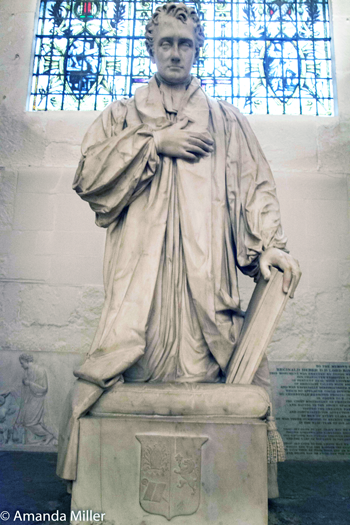 |
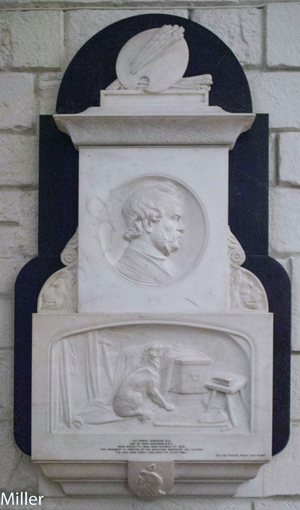 |
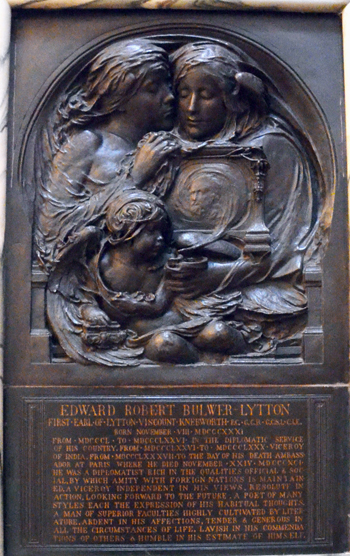 Photograph by George P Landow from The Victorian Web. Used with permission. |
|
Above left: Bishop Randolph Heber (1826) Note the relief of him baptizing, behind and to his right. Above centre: Sir Edwin Henry Landseer (1873) by Woolner (1882). Painter and sculptor, famous for the bronze lions at the base of Nelson's column. The relief at the lower part of the monument is based on his painting The Old Shepherd's Chief Mourner. Above right: Edward George Bulwer-Lytton, 1st Baron Lytton (1873) by Sir Alfred Gilbert (after 1891) Whig politician, novelist, poet and playwright. Quotation: The pen is mightier than the sword. Buried in Westminster Abbey Also - but not shown : John Rennie the Elder (1821) Scottish civil engineer |
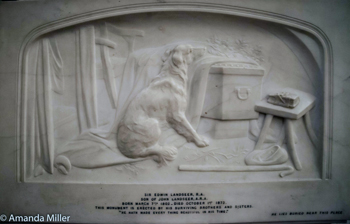 |
|
| South Wall - Third Recess |
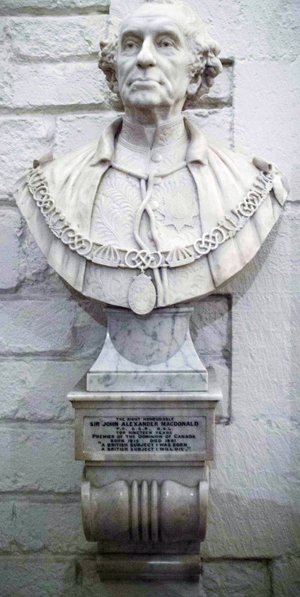 |
NOT SHOWN Bishop John Jackson (1885) Marble recumbent effigy by Woolmer (1887) Lt-Col Sir Duncan MacDougall (1862) Fought in Peninsular War and American War of Independence. Buried in St Paul's Bust by G G Adams J Wasdale (1807) Urn by R Blore Richard Bourke, 6th Earl of Mayo (1872) Viceroy of India and member of British Conservative Party; born in Dublin. Assassinated by a convict while visiting a settlement at Port Blair, Andaman Islands. Buried in the ruined church in Johnstown, Co Kildare. Cpt Thompson by Adams 1860 Sir Henry Parkes (1896) Born in Warwickshire, he emigrated to Australia in 1839 and began working as a labourer. Became a businessman and politician and premier of New South Wales. Bust by Brock 1887 Robert Mylne (1811) Scottish srchitect and civil engineer. Ledger stone. Studied in Rome under Piranesi. His works include Blackfriars' Bridge and the Gloucester and Sharpness Canal [14] Thomas Bennet (1706) Big white marble tablet flanked by Corinthian pillars |
| Sir John MacDonald (1891) Scottish born Canadian politician and the first prime minister of Canada. Buried in Cataraqui Cemetery, Kingston. |
|
First Pier East Face |
First Pier South Face |
First Pier
West Face |
||
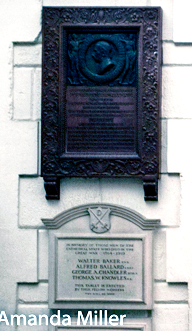 Top: George Richmond (1896) Red marble with bronze roundle by W Blake Richmond. Painter and portraitist. Buried in Highgate Cemetery. This is reproduced as a larger image below Below is a war memorial to cathedral staff who died in Word War I: Walter Baker, Alfred Ballard, George A Chandler & Thomas W Knowles. Note it gives the date as 1914-19, the later being the date of the Treaty of Versailles rather than the Armistice |
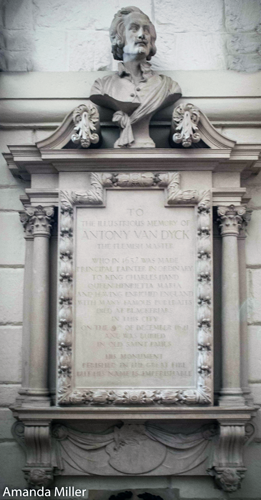 Anthony Van Dyck (1641) by H Poole (1928) Flemish painter and etcher who became a leading court painter, particularly noted for portraits of Charles I and his family. He died in 1641 and was buried on Old St Paul's but his tomb was destroyed in the Great Fire. |
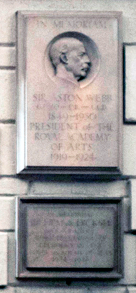 Top: Sir Aston Webb (1930) by William McMillan. Architect and former president of the RA and RIBA. His building include the central building of the University of Birmingham, the main section of the Victoria and Albert Museum, the Admiralty Arch and the Queen Victoria Memorial before Buckingham Place, of which he designed the facade. Bottom: Sir Frank Dicksee (1928) Painter and illustrator. Former president of the RA |
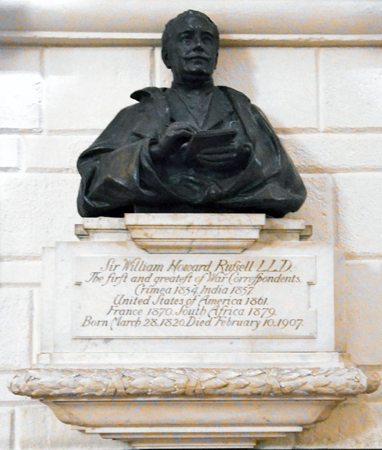 The monuments on the south face of the first pier are mostly war correspondents from the 1900's. Shown is the monument to Sir William Howard Russel LLD (1907) by Sir Bertram McKennal. The inscription states that he was the first of the great war correspondents and reported from the Crimea, India, USA, France and Africa. Photograph by George P Landow from The Victorian Web. Used with permission |
The monument on the west face of the first pier is of
Rev Henry Venn (1873)
by Noble. Hon Sec of the Church
Missionary Society. One of the foremost Protestant
mission stratagists and campaigners. He frequently
lobbied parliament on social issues of the day,
notably on the total eradication of the Atlantic
slave trade. Buried in Mortlake, Surrey NO IMAGE The RCHM also reports: [10] Mary Wren (Mustard) (1712), wife of Christopher; her father, Philip Mustard (1713); her mother, Constance (1729) White marble tablet with scroll, fruit, flowers, cherubs and a cartouche of arms |
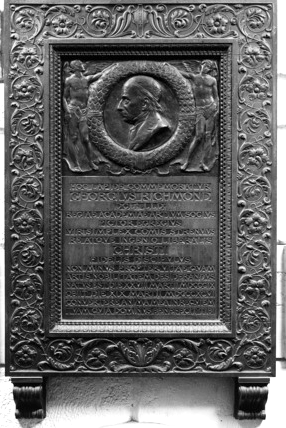 |
| First Pier
North Face |
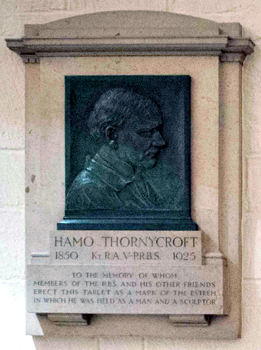 |
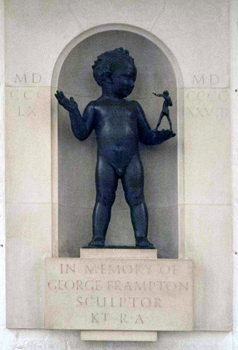 |
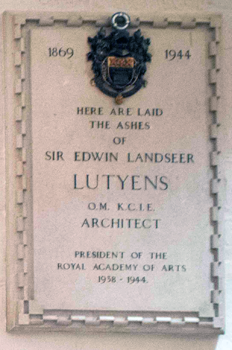 |
Sir William Hamo Thornycroft (1925) by C L Hartwood Sculptor whose works include the statue of Oliver Cromwell, outside the Palace of Westminster, and the statue of King Alfred, at Winchester |
Sir George Frampton (1928) by Ernest Gillick (1930) Sculptor whose work include the Peter Pan Statue and the Edith Cavell Memorial. Bronze child holding a miniature Peter Pan. He was cremated at Golder's Green Crematorium, where his ashes lie. | Sir Edwin Landseer Lutyens (1944) by W Curtis Green (1946) Architect, designer of many country houses and the Cenotaph in Whitehall. Cremated at Golder's Green. |
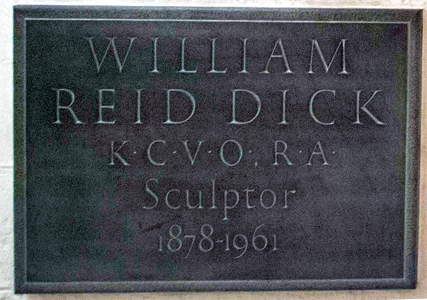 |
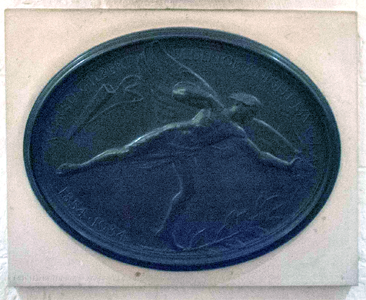 |
 |
William Reid Dick (1961) Scottish sculptor and soldier, in which latter capacity he served with the Royal Engineers in France and Palestine. His works include the Kitchener Memorial, the statue of F D Roosevelt in Grosvenor Square, London and the statue of Lady Godiva in Coventry. Buried in St Paul's |
Sir Alfred Gilbert (1932) by Gilbert Ledward (1936) Sculptor and goldsmith as well as painter in oils. He designed the Shaftesbury Memorial Fountain in Piccadilly Circus, depicting Anteros (but popularly known as Eros), one of the first statues to be cast in aluminium. The latter figure is depicted on the bronze relief. | Sir Henry Maximilian 'Max' Beerbohm (1956) Broadcaster, essayist, parodist and caricaturist. Cremated at Genoa and his ashes buried in St Paul's. |
| Second Pier |
| East Face | South Face | |
| NO IMAGES Robert Claudius Billing (1898) with painted ceramic portrait. Suffragan Bishop of Bedford Benjamin Webb (1885) by Armstead Prebendary at St Paul's One of the founders of the Ecclesiological Society. Writer on ecclesiastical matters and of hymns
The photographs on the right are by George P Landow from
The Victorian Web. Used with permission.
|
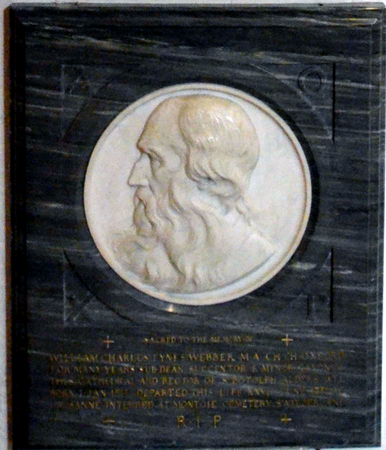 |
 |
| Above:
Sir John Goss (1880)
Composer and organist
and vicar choral at St Paul's. Designed by John
Belcher and carved by Hamo Thornycroft
(1886.) Right: William Charles Fynes Webber (1881) Minor canon, precentor then sub-dean of St Paul's. By W F Woodington Jnr |
||
|
North Aisle of Crypt East End of Eastermost Recess |
 [9] John Martyn (1680) Publisher and bookseller. On the lower tier if the monument (just seen a little above) are shown two babies and two cherubs heads looking over them (above right) He began his own independent business at the sign of the Bell in St Paul's Churchyard in 1651 Attrib to Edward Pierce |
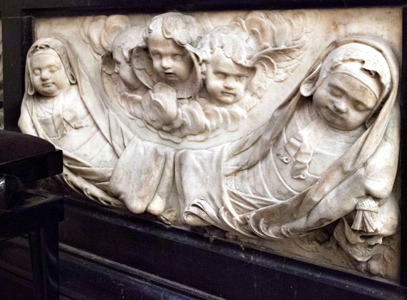 |
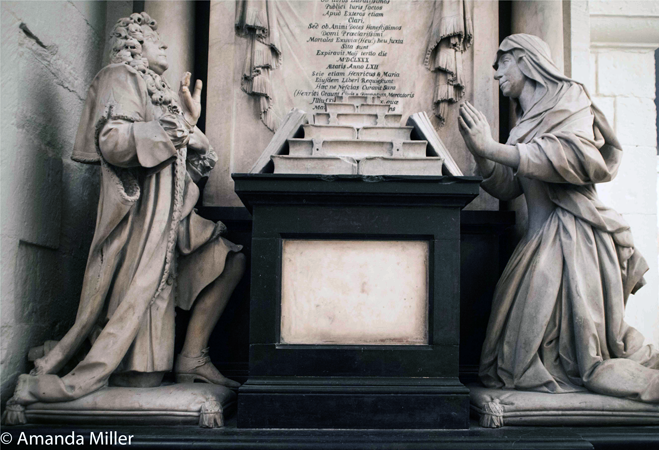 |
| South Wall (going east to west) |
 |
NO IMAGES Frank Holl (1888) Painter and portraitist. Buried in Highgate Cemetery. Portrait bust by Boehm (1889); marble surround by Alfred Gilbert (1893) George Clement Martin (1916) by H Pegram (1917) Organist who served at St Paul's |
Canon Henry Parry Liddon (1890) By Kemp Theologian and chancellor of St Paul's; refused a bishopric. Friend of Lewis Carroll with whom he travelled to Moscow where he made approaches to the orthodox clergy seeking closer links with the C of E He is buried in the Cathedral |
| First Pier - North Face | West Face | |

|
Sir Albert Edward Richardson (1966) Architect and professor of architecture at University College, London. Founder of the Georgian Group and to lived like the Georgians he refused to have electricity installed in his house until persuaded otherwise by his wife. Designed Manchester Opera House and was responsible for much restoration work. Designed by Marshall Sissons; carved by D. McFall | |
| South Face | ||
| Sir William Quiller Orchardson (1910) by W Reynolds-Stephens (1913 Scottish portraitist and painter of domestic and historical scenes, such as Napoleon going into exile aboard the Bellepheron. The small bronze is after one of his paintings | ||
| East Face | ||
|
[8] Mary Corby (Shelly)(1707) Plain oval tabler |
|
North-South Passage West of Screen |
|
|
North Side Sir Stafford Cripps (1952) Bronze bust by Jacob Epstein (1953) British Labour politician who served in the Attlee post-war government, holding the post of Chancellor of the Exchequer, among others. Buried in Sapperton, Gloucester |
South Side Ivor Novello (1951) Portrait bust by John Skelton (1973) Welsh composer and actor, who wrote 'Keep the Home Fires Burning'. Cremated at Golder's Green Crematorium, where his ashes lie. |
| Chapel of St Faith | South-East Recess West Wall |
|
The Chapel of St Faith was converted into the Chapel of the Order of the British Empire in 1960. Some movement and alteration of monuments were made. A floor slab marks the grave of Canon Henry Liddon whose monument is shown above. (No Image) A raised monument to Dean Millman was removed when the OBE chapel was refurbished and a floor slab replaced it. Below is the floor slab marking the grave of Mandell Creighton (1901) Historian and Bishop of London & his wife, Louise (on Glenn) (1936), advocate on women's rights and suffrage. Also In ambulatory SE recess [7] Sir Simon Baskervile (1641) Tablet with scrolls, cherub head and achievement of Arms (RCHM) |
 Brian Walton (1661) Bishop of Chester I am uncertain if this monument is sited here |
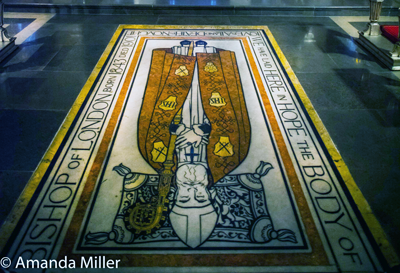 |
|
| The Wellington
Tomb The tomb is situated at the west end of the Chapel of St Faith in what might be called a porch or ante-room |
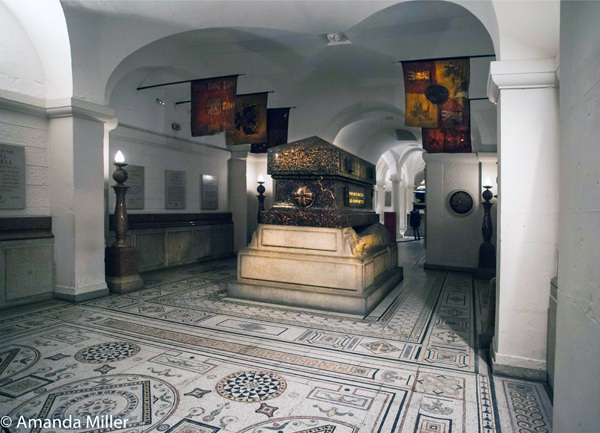 Tomb of Field Marshal Arthur Wellesley, First Duke of Wellington (1852) . The plinth is of gray granite and the sarcophagus - by Penrose (1855) is of Cornish Porphyry. |
Other Monuments |
| On the walls around the monument can be seen a series of
simple tablets to 20th century soldiers (1979) General Sir Sam Browne VC (1901) Relief of a sepoy by Forsyth (1903) During the Indian Mutiny of 1857 the then Captain Sam Browne had his left arm severed at the shoulder by a sword cut in battle. He was awarded the VC for this engagement. Without his left hand he was unable to control his scabbard or draw his sword and he came up with the idea of wearing a second belt over the right shoulder which would hook into the heavy leather belt around the waist and hold the scabbard and sword in position. Hence the origin of the 'Sam Browne' It is traditionally worn by those entitles to carry swords - commissioned officers and warrant officers - although for most of its history it has supported a heavy pistol. |
|
N-S Passage East of Rotonda |
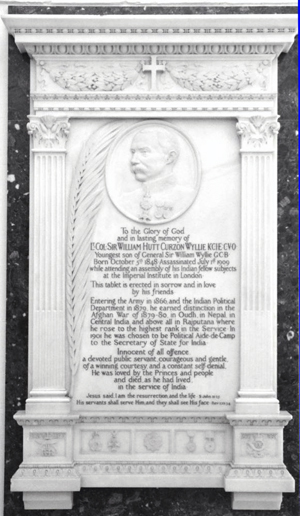 |
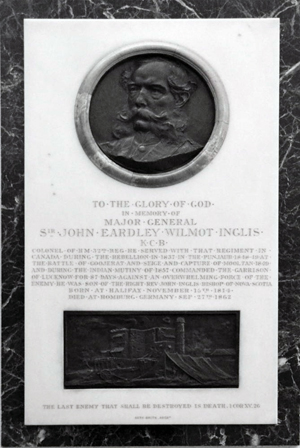 |
 |
|
Above left:
Lt Col Sir William Hutt
Curzon Wyllie (1909) Marble.
He served in
the Afghan War and in India, where
he occupied a number of administrative and
diplomatic posts.
He was assassinated by an revolutionary Indian
student in London
while attending an event with his wife. He was buried in
Richmond, Surrey. The photographs above and to the right are by George P Landow from The Victorian Web. Used with permission. |
||
|
Under the Dome The Rotonda |
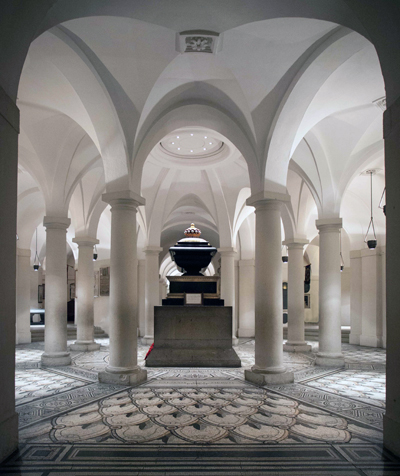 |
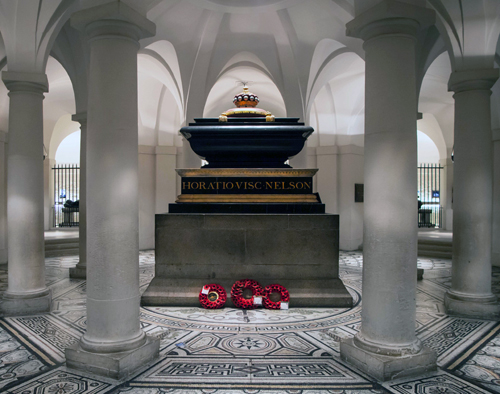
[15]
Vice Admiral Horation Nelson (1805)
The black marble sarcophagus was made by
Bernadetto de Rovezzano (1524-9) for the tomb
of Cardinal Wolsey, who was to have been buried at
Windsor but fell out of favour of Henry VIII. The pedestal pf granite and black and white
marbly was probably by Mylne (1806-7)
|
| Bays around the Rotunda We begin with the east bay (no. the first) - along the long west-east axis of the crypt - and progress clockwise. |
| First Bay |
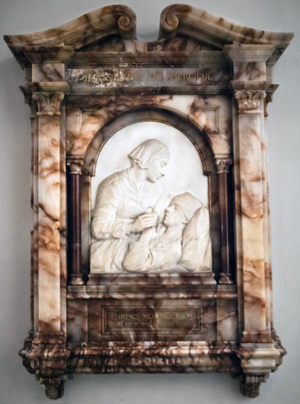 |
Florence Nightingale (1910) Red marble and alabaster by A G Walker (1916). Social reformer, statiscisian and founder of modern nursing. The 'lady with the lamp' came into prominence during the Crimean Way She is buried in East Wellow, Hampshire. The offer of burial in Westminster Abber was declined by her relatives. |
| Second Bay |
 |
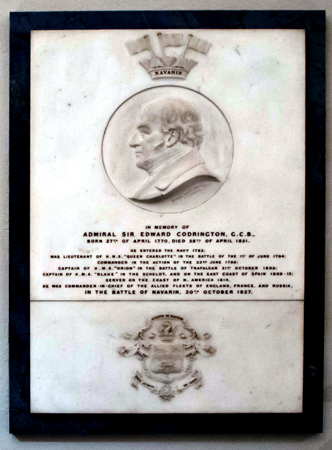 |
 |
| Admiral Charles William de la Poer Beresford, 1st Baron Beresford (1919) Popular 'Charlie B' managed to combine being a naval officer and a MP. His later career sufferend owing to a long standing dispute about naval reforms with Admiral of the Fleet Sir John Fisher, who blocked his promotion. Buried Putney Vale Cemetery, South London. By Tweed | Admiral Sir Edward Codrington (1851) Hero of Trafalgar and Navarino. Said to have been buried in St Peter's Eaton Square but records examined in 1954 state that he was buried in Brookwood Cemetery. | Admiral of the Fleet Sir Frederick W Richards (1912) Rose to become First Naval Lord By Pomeroy. The bust is described as 'blurry' by Pevsner no it is not the photograph! |
 |
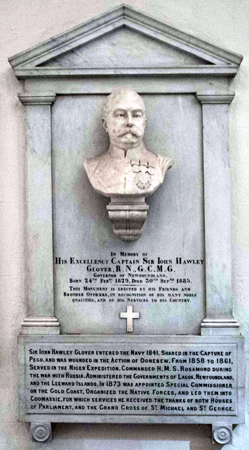 |
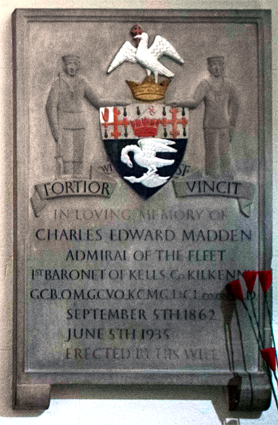 |
| Admiral of the Fleet Sir Henry Bradwardine Jackson (1929) Pioneer of ship to ship wireless communication. WWI naval officer whose reputation suffered when German destroyers appeared in the Channel 1916 |
Captain Sir John Hawley Glover
RN (1885) Naval officer and later colonial governor Marble bust |
Admiral of the Fleet Sir Charles Edward Madden Bt (1935) WWI naval officer |
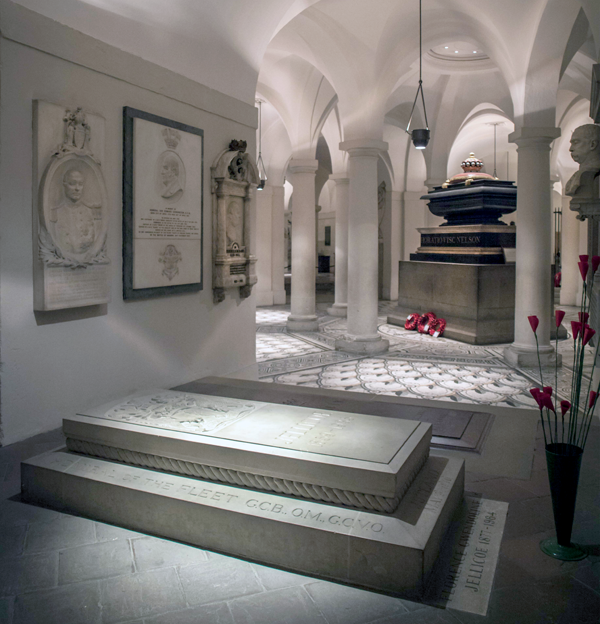 |
Left: The floor monument in the foreground covers the grave of Admiral of the Fleet John Rushworth Jellcoe, 1st Earl Jellicoe (1935). He fought in the Anglo Egyptian War, the Boxer Rebellion and commanded the Grand Fleet at the Battle of Jutland in 1916 during Word War I. He became First Sea Lord before being relieved of his post at the end of 1917. In the 1920's he became Governor General of New Zealand. The floor slab in the middle ground may be that of Admiral of the Fleet David Beatty, 1st Earl Beatty (1936) who was buried in this bay. The slab is by Lutyens (1938). He was involved in the Mahdist War and commanded the First Battleship Cruiser Squadron at the Battle of Jutland. His aggressive approach was contrasted with that of the cautious Jellicoe but, whereas Jellicoe made no serious errors, it has been identified that Beatty did. He followed Jellicoe's career becoming Commander-in-Chief of the Grand Fleet and First Sea Lord in 1917, a post he held for a record of over seven years. He married a wealthy American heiress, which enabled him to lead a more independent life than most other officer. He insisted acting as pall bearer at the funeral of his old chief, Jellicoe in 1935 even though he was seriously ill; in fact a member of the crowd sent him a glass of brandy. This and other unwise actions may have hastened his own death the following year. He had asked to be buried next to his wife at Dingley, Leicestershire but this request was ignored and he was buried at St Paul's, the last burial to take place there In the background is Lord Nelson's tomb and on the wall can be seen the monuments to a number of Naval Officers which are detailed above. |
| Fourth Bay | |
 |
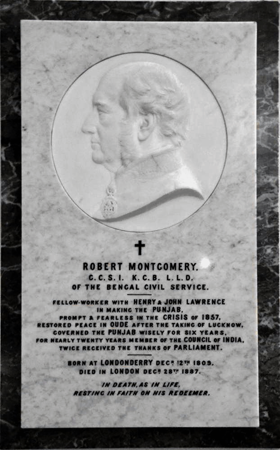 |
|
Field Marshal Robert Cornelis Napier, 1st
Baron Napier of Magdala (1890)
1st and 2nd
Anglo-Sikh Wars, Indian Mutiny, 2nd Opium War and
Expedition to Abyssinia. C-in-C, India. Buried in St
Paul's. By Woodington (1891) |
Sir Robert Montgomery (1887) of the Bengal Civil Service. Buried at Londonderry.This monument is almost certainly the one to the right of the monument to our left. Photograph by George P Landow from The Victorian Web. Used with permission. |
| Fifth Bay (This is the passage from the Rotunda to the Nave) |
||
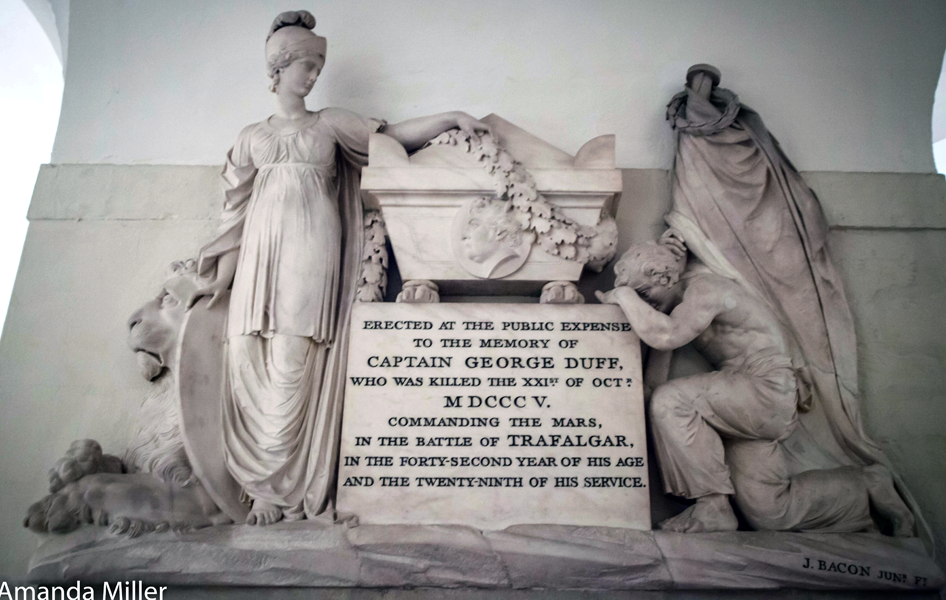 |
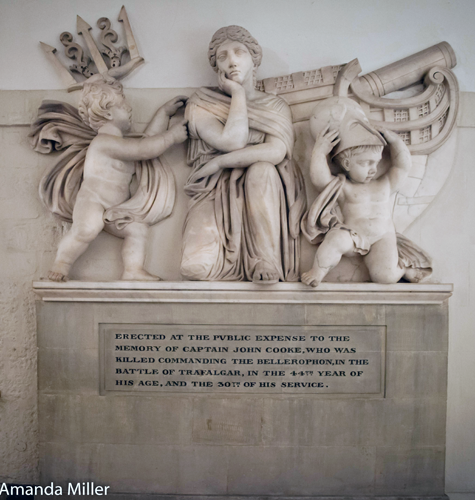 |
.png) |
| Left: Captain George Duff
RN
(1805)
Followed the same service career
as Captain Cooke (right) Killed by a cannon ball at
Trafalgar. Buried at sea. By Bacon Jnr Right and above: Captain John Cooke RN. (1805) American War of Independance, French Revolutionary Wars and Napoleonic Wars. Killed on board Bellerophon during hand to hand fighting at Trafalgar. Buried at sea. By Westmacott (1807-10) |
||
| The above monuments to Captains Duff and Cook were moved into this position for the body of the church to make room for the organ |
 |
Sixth Bay |
| Left: Col T E Lawrence (1935) Bronze bust by Eric Kennington. 'Lawrence of Arabia' Buried St Nicholas, Moreton, Dorset. There is also a recumbent effigy in St Martin's, Wareham, Dorset. Q.V. | |
| Seventh Bay | |
| Eighth Bay | |
| Lt-Gen Bernard Cyril Reyberg, 1st Baron Freybery VC, DSO and 3 bars (1963) Bronze by Oscar Vernon. He was the youngest general in WWI and led the New Zeeland Expeditionary Forces in WWII. 7th Governor-General of New Zeeland. Buried at St Martha's, near Guildford, Surrey |
| The Transepts |
| These are referred to in Pevsner as
the North and South Crossing Aisles; I will use the
more familiar terms North and South Transepts They house the parts of the fire damaged monuments that were salvaged from the Great Fire; I have included copies of etchings by Wencelaus Hollar (fron Dugdale's St Paul's) to place alongside Amanda's photographs of the fragments of the monuments. There are more of these etchings below of monuments that were completely destroyed. Also in the transepts are large monumets to later worthies which were brough down from the main body of the church. |
| South Transept |
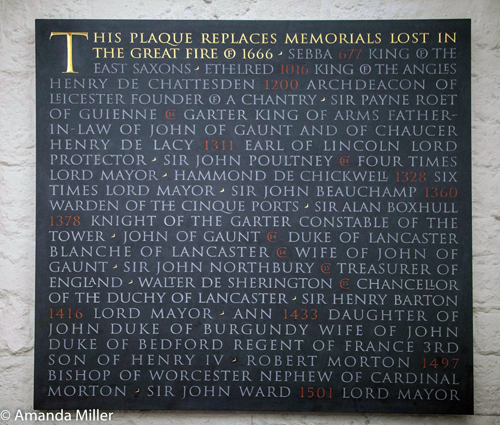 |
 |
| There were more monuments than those listed above as can been seen from the plan of the Old Church |
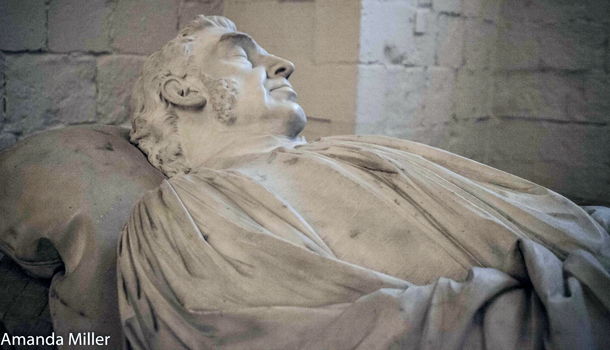 |
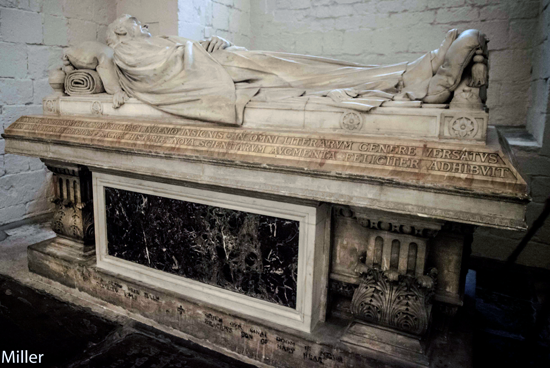 |
|
Dean Henry Hart Millman (1876) By F J
Williamson Historian and Dean of St Paul's. He wrote the
hymn 'Ride On Ride On In Majesty' Note the entry in Wikipedia is confusing when it states that he was buried in the Crypt with an elaborate tomb which was replaced by a simple slab.... See above Chapel of St Faith. The above is a monument not a tomb. |
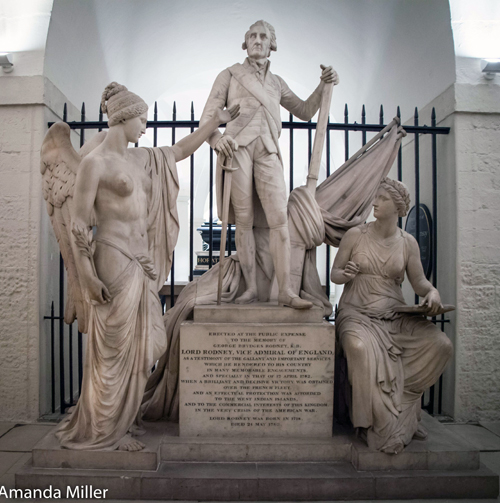 |
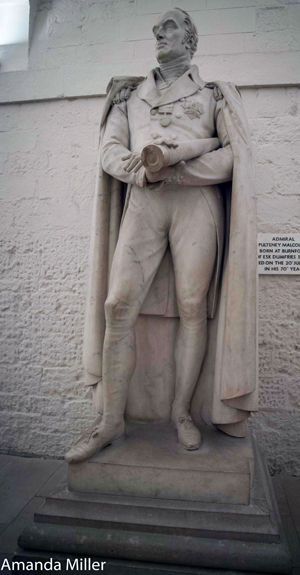 |
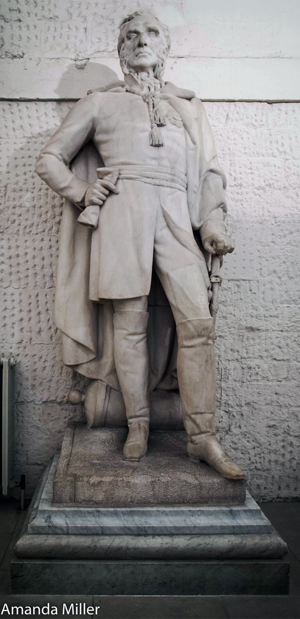 |
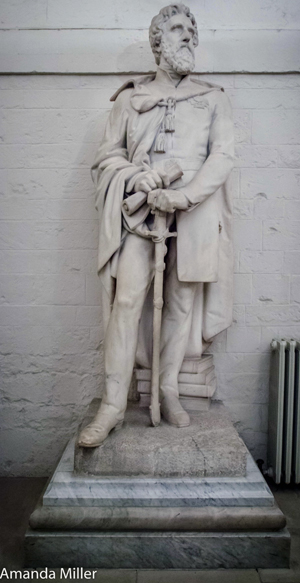 |
| Admiral George Brydges Rodney, 1st Baron Rodney (1792) by Rossi (1810-15) Went to sea at 14 and rose through the ranks. Although a very capable officer, he was also vain, selfish and unscrupulous in his pursuit of prize money and furthering the fortunes of his family . Saw service in War of Austrian Succession, Seven Years' War, American Revolutionary War. Four Anglo-Duthch War. Buried at Old Arlesford, Hampshire. Rodney A street in Liverpool is named after him. | Admiral Sir Pulteney Malcolm (1832) by E H Baily (1842) Served in American and French Revolutionary Wars, War of 1812 and Napoleonic Wars. | General Sir Charles James Napier (1853) by G G Adams (1856) Served in Peninsular War; C-in-C India. Buried in Royal Garrison Church, Portsmouth. The city of Napier in New Zeeland is named after him as well as ten English Pubs. | General Sir William Francis Patrick Napier (1860) by G G Adams (1860) Brother of Sir Charles. Soldier and military historian. Served in Peninsular War. Buried West Norwood Cemetery, London. |
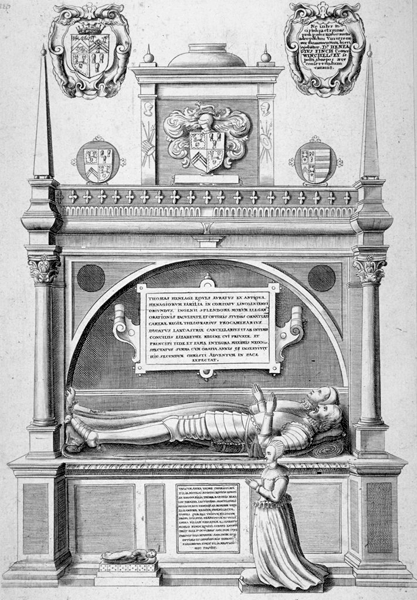 |
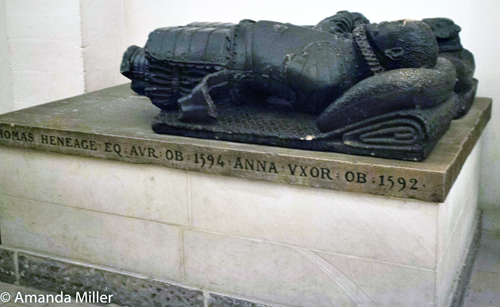 |
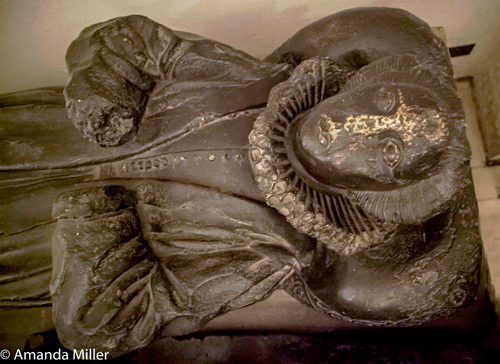 |
 |
 |
|
|
[6]
Sir Thomas
Heneage (1594) and his wife, Anne (1592)
MP and
courtier at the court of Elizabeth I. Marble Left is a Hollar etching of the whole monument. Note the kneeling girls in front of the recumbent parents and the child represented as sleeping |
||
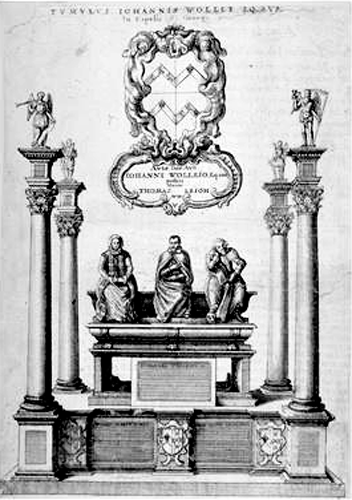 |
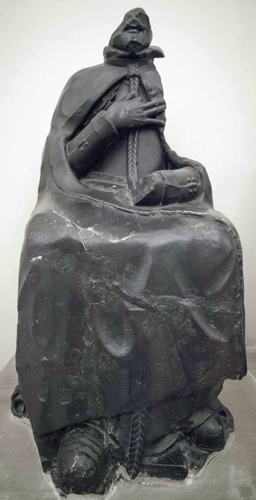 |
 |
 |
|
| [4] Sir John Wooley (1595) and his wife, Elizabeth. MP and Queen Elizabeth I's Latin secretary | ||||
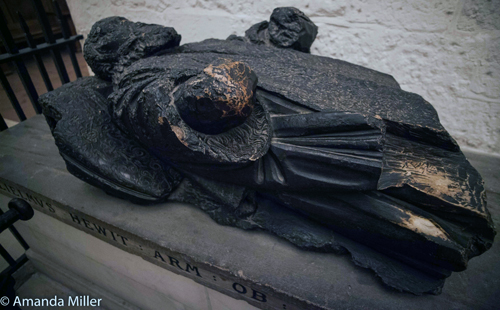 |
| [3] William Hewitt (1599) Marble |
| North Transept |
 [2] Sir William Cokayne (1626) & Mary (Morris) Lord Mayor of London. Marble |
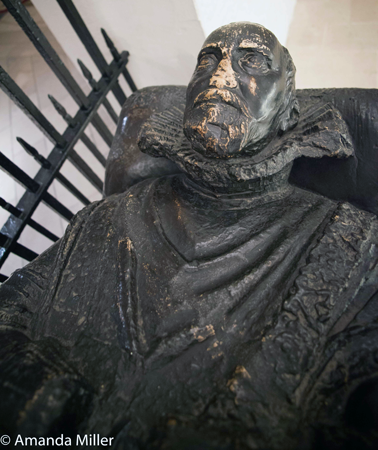 |
 |
| Where's the error? William Cokain was certainly buried in St Paul's and I think we can be sure that that is his fire damaged effigy above. However the etching says 'Charles Viscount Cullen.'Sir William's eldest son, Charles, was created Viscount Cullen in1642 and died in 1661. So the monument could indeed be his, although it is not listed on the plaque above. Sir William had one son and six daughters: and one son and six daughters kneel at the tomb, indication the monument could be that of Sir William but wrongly inscribed. Unfortunately I cannot discover how many children Charles had: this would be concluding evidence. |
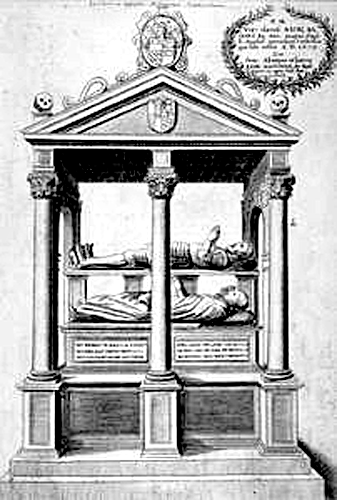 |
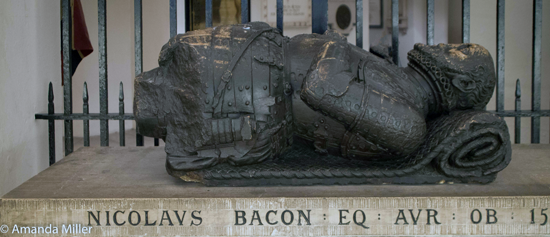 Above left and right: [5] Sir Nicholas Bacon (1579) Marble |
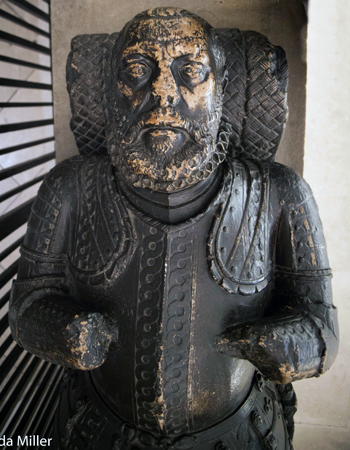 |
|
| Sir Philip Sidney by Lida Lopes Cardozo and David Kindersley (1986) Not Shown |
|
North-South Cross Passage West of the Rotonda |
|
|
| The Nave |
|
|
|||||||||||||||
| Against Westen Piers |
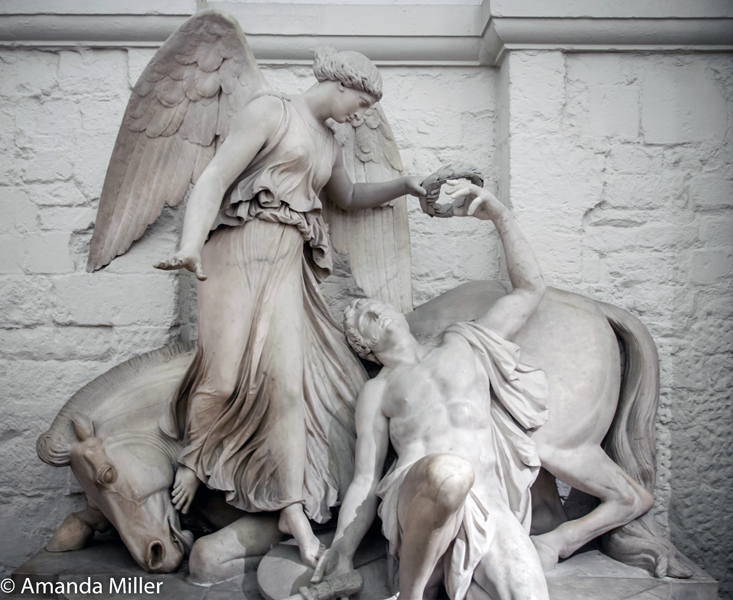  |
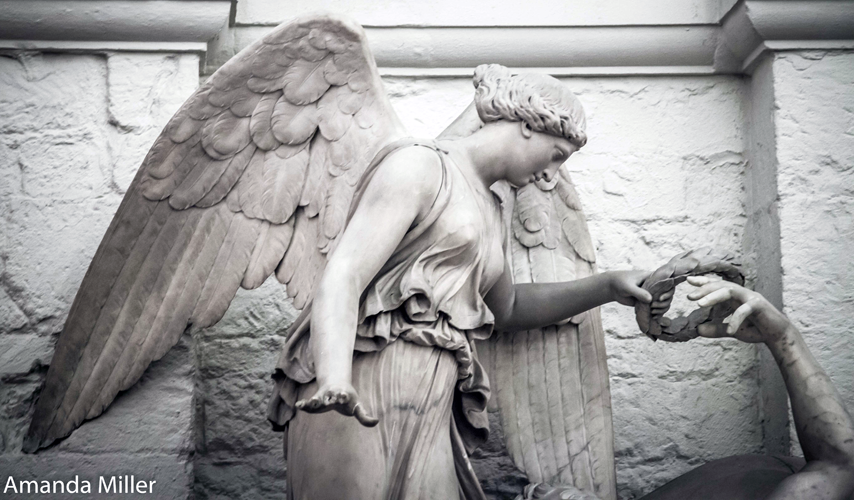 |
| Above and above left:
Major- General Hon Sir William Ponsonby (1815) Anglo-Irish politician and army officer who served in the Peninsular War and was kiiled in the Battle of Waterloo. Designed by Theed; carved by Baily (1816-20) Below and below left: Captain James Robert Mosse RN (1801) and Captain Edward Riou RN (1801) Cpt Mosse was killed at the Battle of Copenhagen during the Napoleanic War about HMS Mon)arch. He was buried at sea. Captain Riou was also killed in the same battle aboard HMSAmazon. by Rossi (1805) |
|
 |
| West End |
| Admiral Duncan
by Westmacott (1823-6) Hon M Elphinstone by Nobel (1863) |
In Nave South Aisle Thomas Newton (1807) Relief by Westmacott |
| Monuments Lost in the Great Fire |
| These monuments appear to have been totally
destroyed in the Fire of London and left no remains. They were recorded in Dugdale's St Paul's which was illustrated by etchings executed by Wencelaus Hollar. My copy of this book was stolen, together with many others, several years ago and all sold to an unscrupulous book dealer in North Yorkshire. I could not replace the antiquarian book but found a copy of the etchings in a modestly priced book a few years ago; these are reproduced below. I personally find the etchings of Hollar rather coarse and heavy so the theft of this book was not all that disastrous. |
 Above: on the left is the tomb of Sebba (also spelled Sæbbi or Sebbi) (626?-695). His tomb survived the fire of 1087 and his remains were later transferred to a black marble sarcopagus in the mid 12th century, which I presume is what we see here. This did not survive the Great Fire. Sebba and his cousin, Sighere became joint kings of Essex on the death of their predecessor in 664 but a rivalry developed with the apostatization of Sighere the following year while Sebba remained a Christian. He become sole king on the death of his brother and abdicated in 694 to entere a monastry. He died the following year. On the right is a similar tomb of Æthelred the Unræd (c 966-1016). Often called 'Ethelred the Unready' owing to a mistranslation of the Anglo-Saxon word of his nickname. His name means 'noble council' and the nickname (added after his death) is an oxymoron meaning 'no council'. He was son of King Edgar and his second or third wife, Ælfthyth. He became king at twelve following the assassination of his elder half brother, Edward the Martyr, which was carried out by his supporters although it is unlikely that the young Æthelred was himself involved. During his reign in the 980's the Danish raids started again after several decades of relative peace. Following the Battle of Maldon (991) in which the Anglo-Saxon defeat the King was advised to buy off the Danes rather than continue the armed struggle, paying Danegeld, effectively 'protection money.' In 1002 Æthelred ordered the St Brice's Day Massacre of Danish Settlers which the following year provoked King Sweyn Forkbeard of Denmark to invade England. After loosing an armed struggle the English King and his sons fled to Normandy in 1013 and Sweyn was declared King of England on Christmas Day that year. However Swyen died the following year and Æthelred returned to England. Æthelred died in 1016 and was succeeded by his son Edmund Ironside. There is a lot more detail to complex and interesting story which can be read by following the links. Who needs fiction when you can read history! |

|
 |
|
|
Above Left: John of Gaunt, Duke of
Lancaster ( 1340- 1399) and his wife, Blanche of
Lancaster (1347 - 1368).
John of Gaunt (Gaunt probably from his
birth place, Ghent) was the third of Kind Edward III's five
sons who reached adulthood. His early career was spent fighting in France with his father and brother during the 100 Years' War. Most of his sole exploits were failures, including the attempt to reach Aquitaine from English held Calais, a 560 mile journey of five months. Although this was highly regarded at the time virtually nothing was achieved and one third of his men were lost, many through disease. He was generally blames from the failures during later part of this phase of the War. His first wife was Blanche of Lancaster, daughter of Henry of Grosmont, 1st Duke of Lancaster and it his from this marriage than John inherited his vast estates, wealth and titles. This marriage produced seven children but Blanche died in 1368. In 1371 he had married Constance of Castile, daughter of King Pedro the Cruel who had been murdered by his half brother, Henry the Fratricide. During his marriage to Constance, by whom he had two children, he began an affair with Kathryn Swynford, an affair which produced four illegitimate children, called the Beaufords, (three boys and a girl). After Constance's death in 1394 he married Kathryn and the children were legitimized by an act of parliament, but barred from the throne. He returned to England from France in 1374 and eventually during his father's old age and the incapacity of his brother, the Black Prince, he assumed control of the government. He continued to protect John Wycliffe, possibly to counteract the growing political power of the church. However he became increasingly unpopular partly because of the setbacks in the 100 Years' War and the high taxation. He had annulled the majority of the reforming acts that the recent parliaments had passed; his unpopularity was not helped by his ostentatious wealth and haughty manner. Moreover he had neither the charisma nor had achieved the military triumphs of his father or his brother to even begin to counteract this increasing unpopularity. He made a failed attempt to seize the Castilian Crown in 1376, even making an alliance with King John of Portugal, who married Gaunt's daughter, Phillippa. His eventually failure led to his making a secret alliance with John of Castile, whereby Constance renounced her claim to the throne and Gaunt's daughter with Constance, Catherine, married son of King John of Castile's son Henry. King John was the son of Henry the Fratricide mentioned above. He left the Iberian Peninsula for Aquitaine where her was appointed governor and, in due course, succeeded his brother as Duke. Again he proved unpopular and unsuccessful, the Gascons resenting his rule, as they had until recently been ruled directly by the English crown. He returned to England in 1889 where he was a great influence during the minority of Richard II, his nephew, mediating between the King and rebellious nobles, including his son Henry of Bolingbroke. He made some disastrous political decisions, such as on taxation which led to the Peasants' Revolt; in fact the rebels destroyed his house in London in their anger against him. He died in 1399 and his estates were declared forfeit to the crown. This act of malicious folly led to the invasion of the future Henry IV and Richard's deposition and death. Above right: John Donne (1631) The poet and Dean of St Pauls.The monument was not completely destroyed during the fire: the effigy only was recovered and restored (see above) |
|||
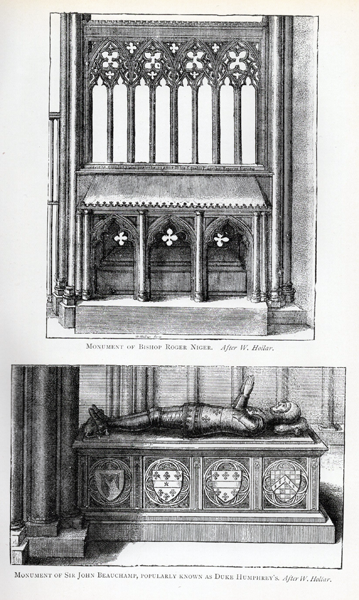 |
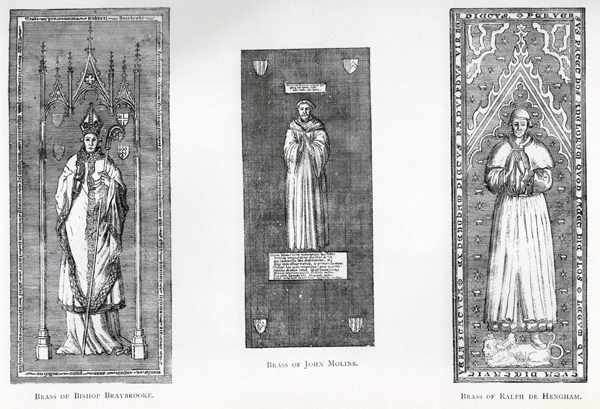 |
 |
|
Left top:
Bishop Roger
Niger (1241) became Bishop of London in 1229. His
body was buried in St Paul's although his heart was taken to
Beeleigh Abbey near Maldon (Essex); both places became sites of
pilgrimage although he was never formally canonized. Left bottom: Sir John Paveley de Beauchamp (c.1316-60) Admiral of the Fleet, 1st Baron Beauchamp of Warwick. He carried the royal standard at the Battle of Crécy and was present at the Siege of Calais becoming captain there for two years. Sometimes wrongly said to be the tomb of Humphrey, Duke of Gloucester, Henry V's brother. Above left: Robert Braybrooke (1404) Bishop of London, consecrated 1382 Above centre: John Molins no information Above right:Sir Ralph de Hengham (1311) Justice. He held three cathedral canonies (St Paul's, Hereford, and Litchfield), five prebends in collegiate churches, and a number of livings in ten counties. In his defence he was the first recorded chief justice to spend time after the case to explain points of law to students and other observers. See below for superstructure Right: Shrine of St Erkenwald (693) Anglo-Saxon bishop pf London 675-693 |
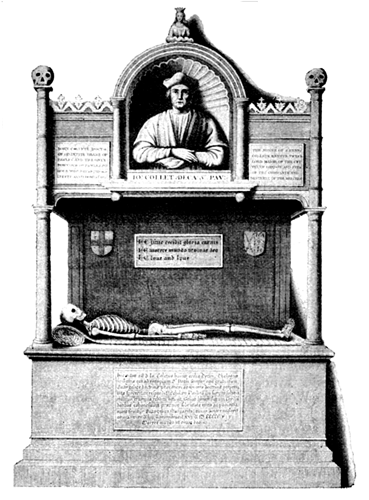 |
 |
 |
 |
|
Dean John Collet
(1519) Scholar, Christian Humanist and Member of the Worshipful Company of Mercers. |
Sir Ralph de
Hengham (1311) See above for details of brass and mini-biography |
Sir Simon Burley
(1388) Although he was of humble origin he became a friend of the Black Prince and tutor to his son, the future Richrd II. He became very influential during the latter's reign. Impeached and executed at the Merciless Parliament |
Dean Alexandre Nowell (1602) A keen angler who is said to have invented bottled beer As a Protestant he went into exile during the reign of Bloody Mary |
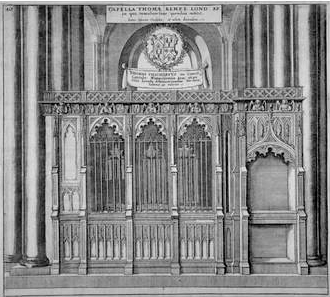 |
 |
|
|
Thomas Kempe
(1489) Bishop of London |
Henry de Lacy, Earl of Lincoln (1311) Served with Edward I in Wales, Scotland and France. During Edward II's reign joined the Lords Ordainers where he was a 'moderate' ; was Regent during Edward's absence in Scotland |
The positions of these lost (and partly destroyed) monuments may be found on the plan here
TO BE , EXTENDED AND AMENDED
All photographs - except where indicated - are © Amanda Miller of Amanda's Arcade, to whom grateful thanks.
<City of London I> <City of London III> <City of Westminster-1> <City of Westminster-2> <City of Westminster-3> <City of Westminster - 4> <Borough of Kensington & Chelsea> <Borough of Wandsworth>
Can anyone help?
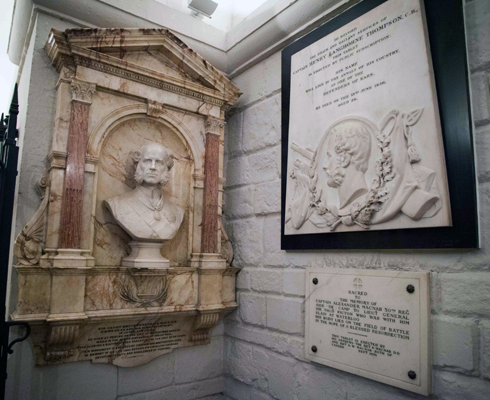 |
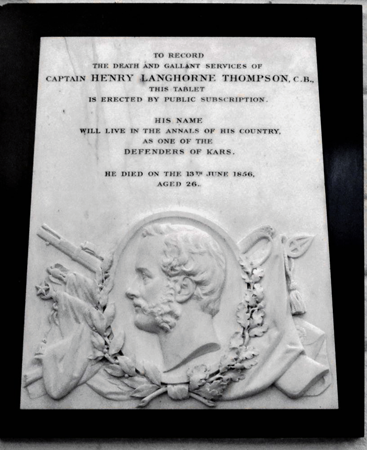 |

|
 |
 |
Left
Sir Harry Smith Parks Above Cpt Henry Langhorne Thompson (1856) also right Left bottom: Cpt Alexander McNab 30th Reg Aide-de-Camp to Lt Gen Picton. KIA Waterloo. Body buried there Photographs by George P Landow from The Victorian Web. Used with permission.George P Landow from The Victorian Web. Used with permission. |
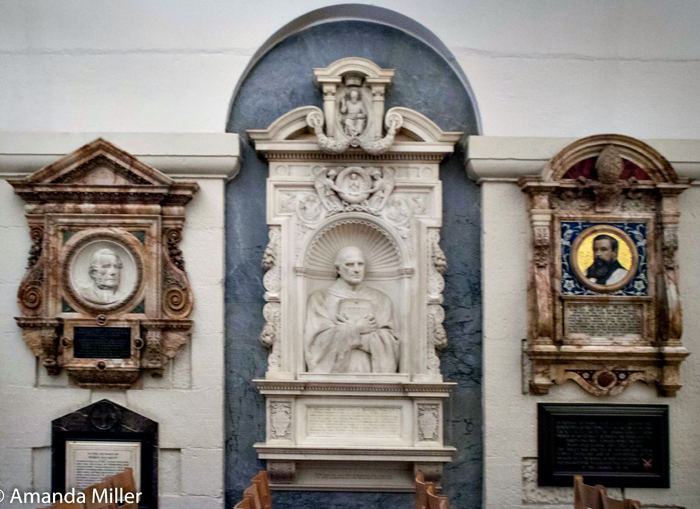 |
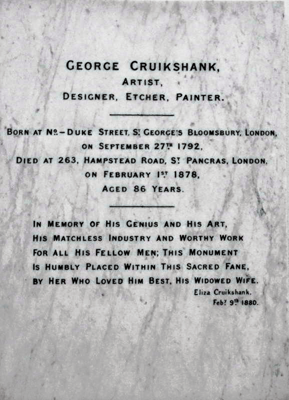 |
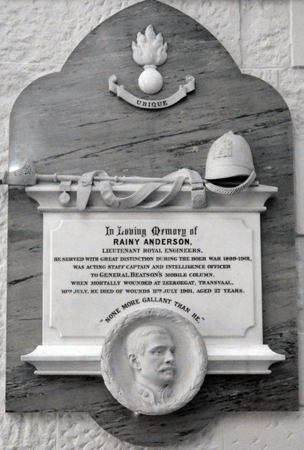 |
||
| Unknown |
